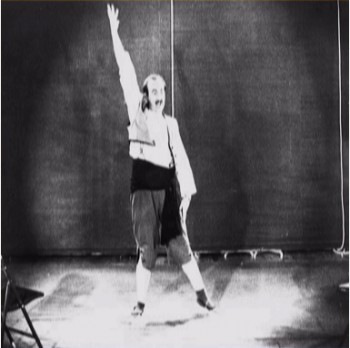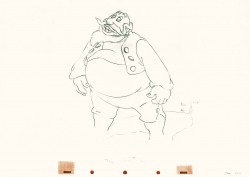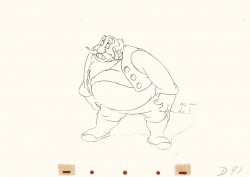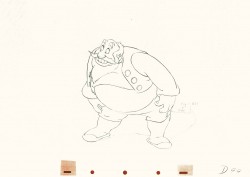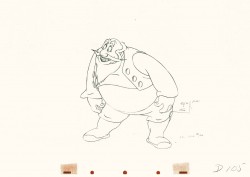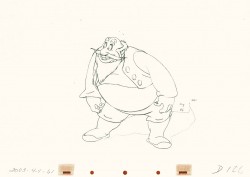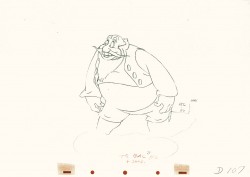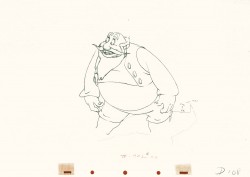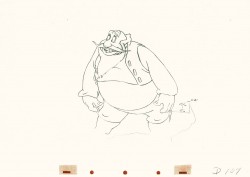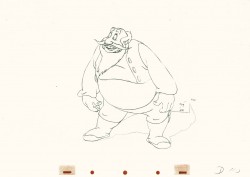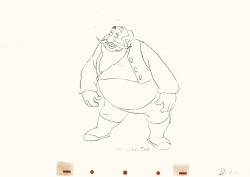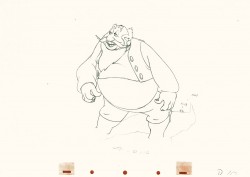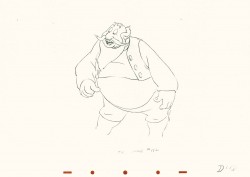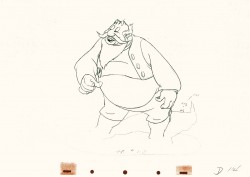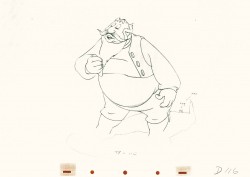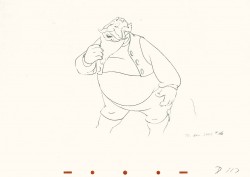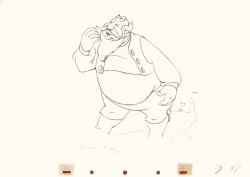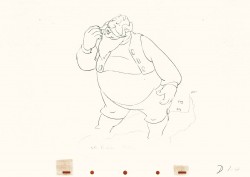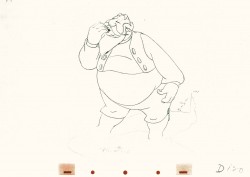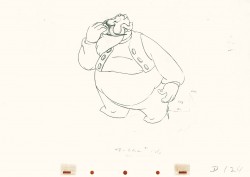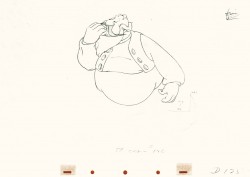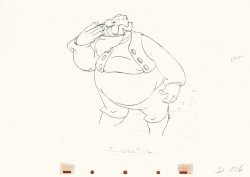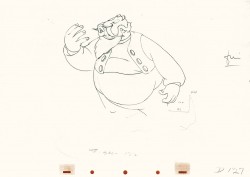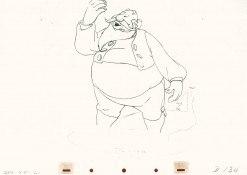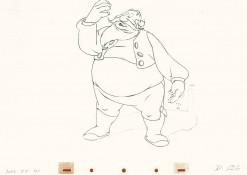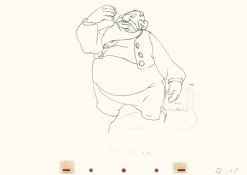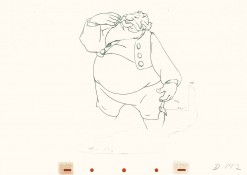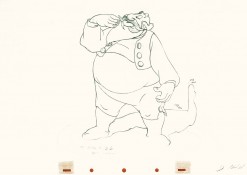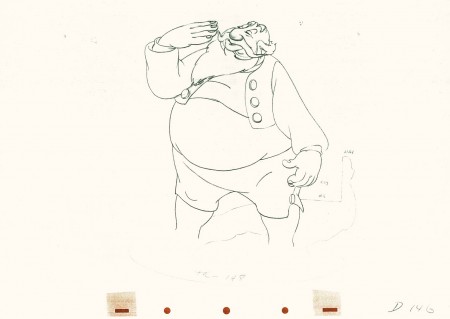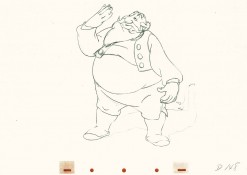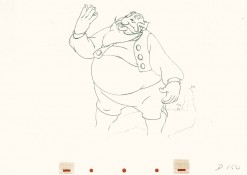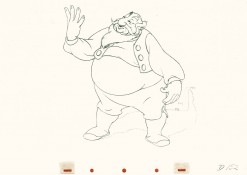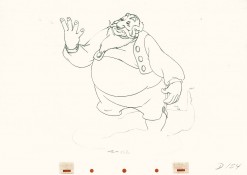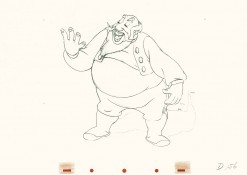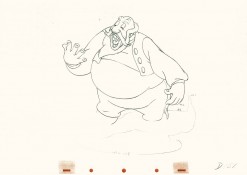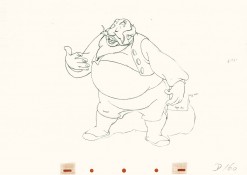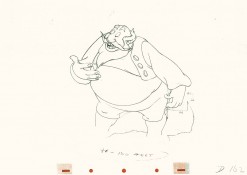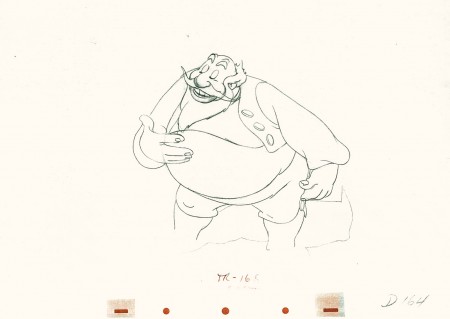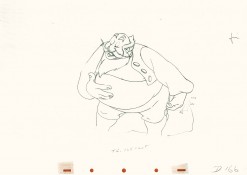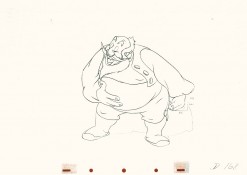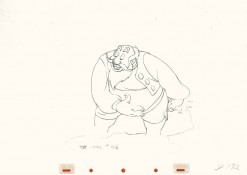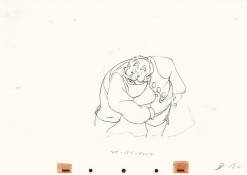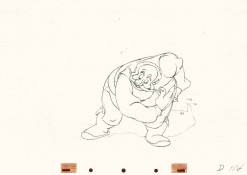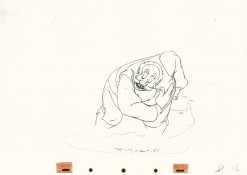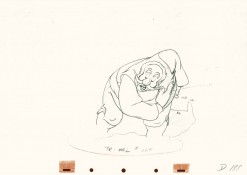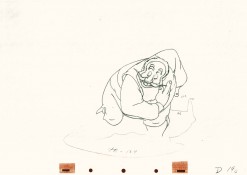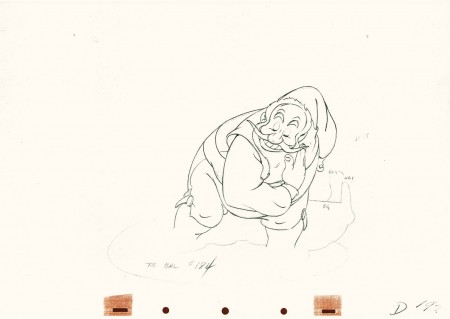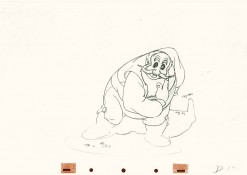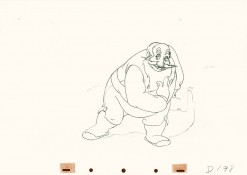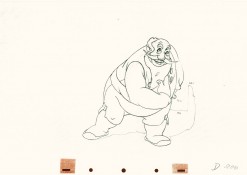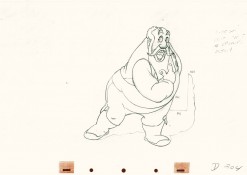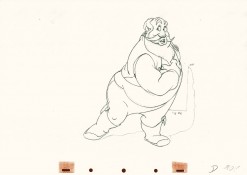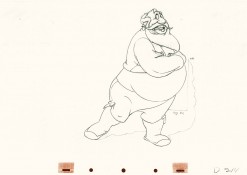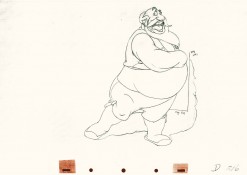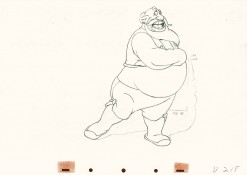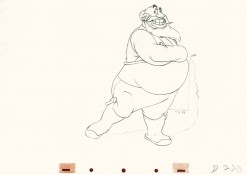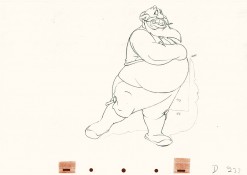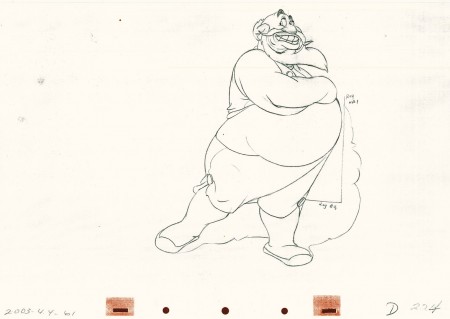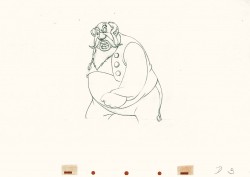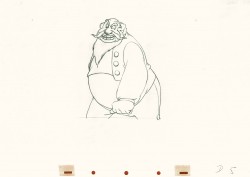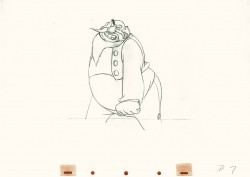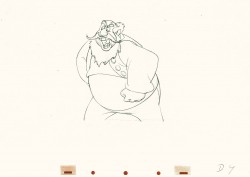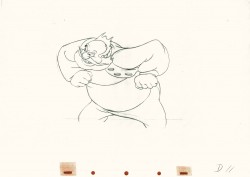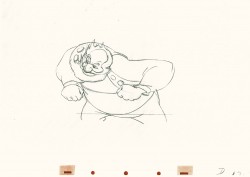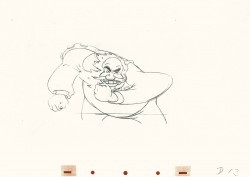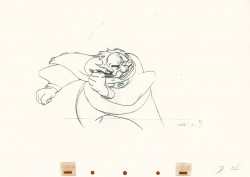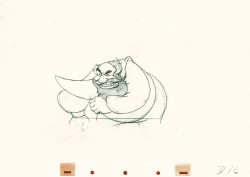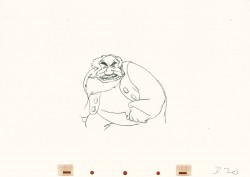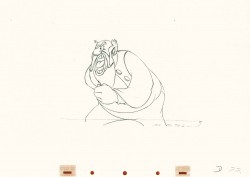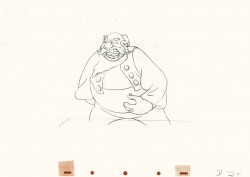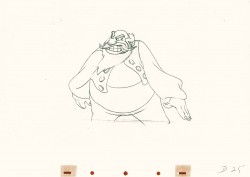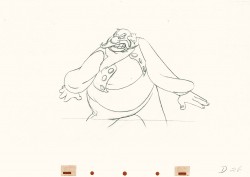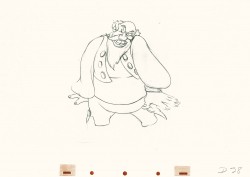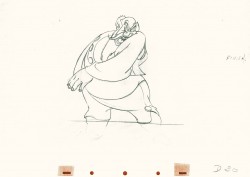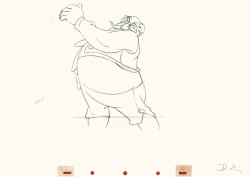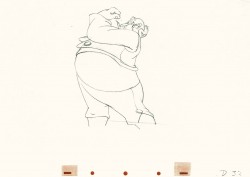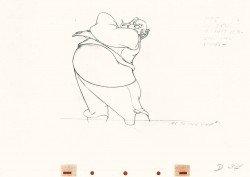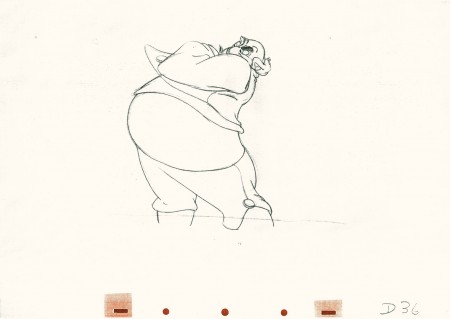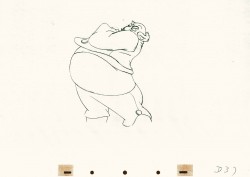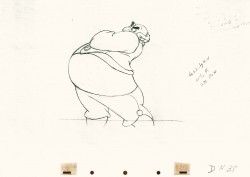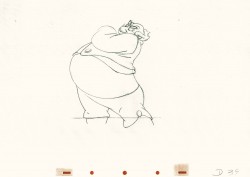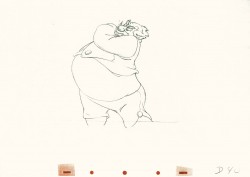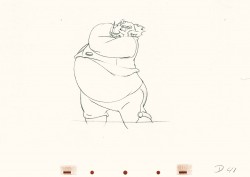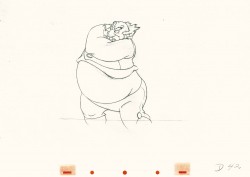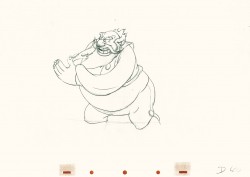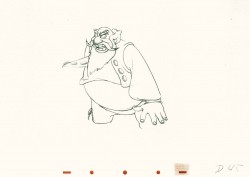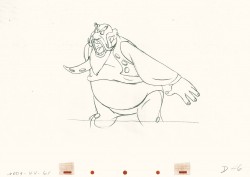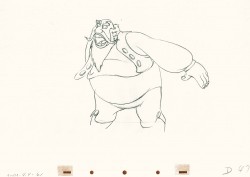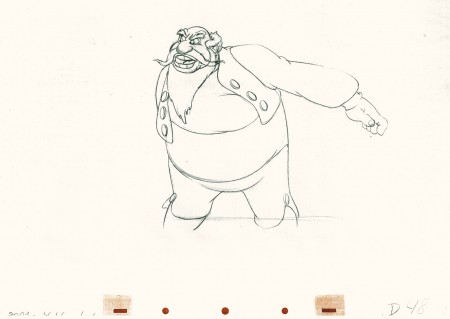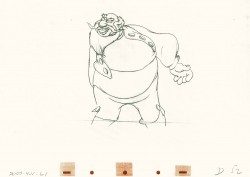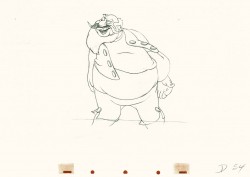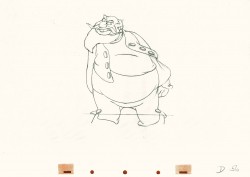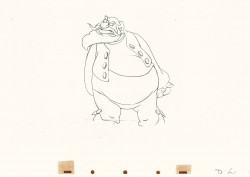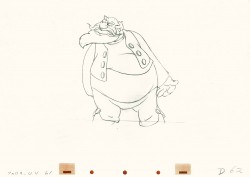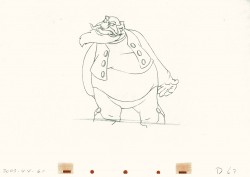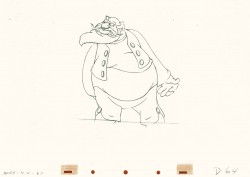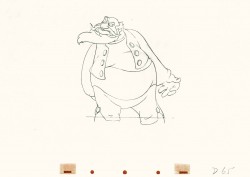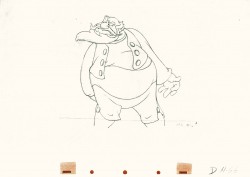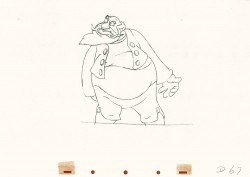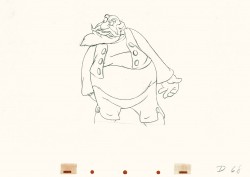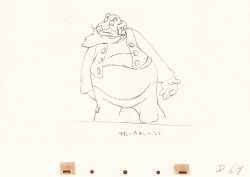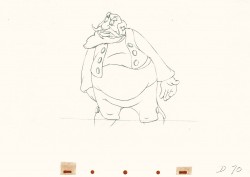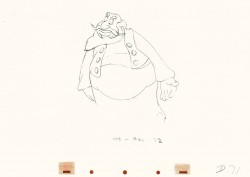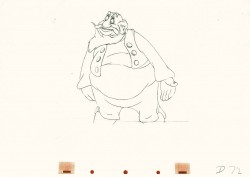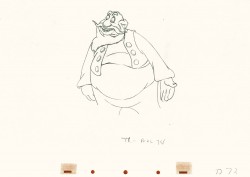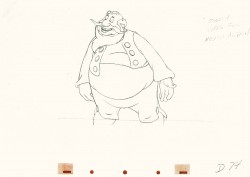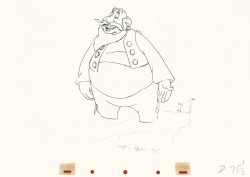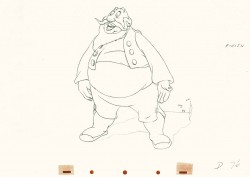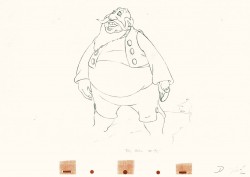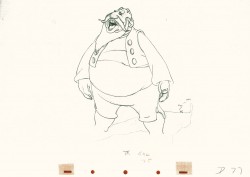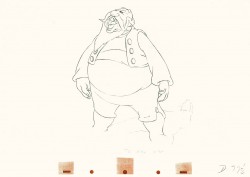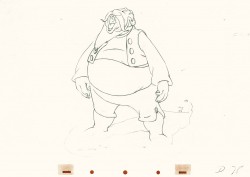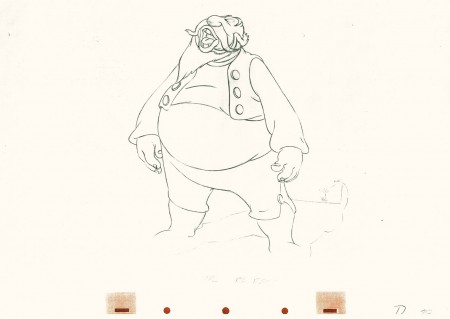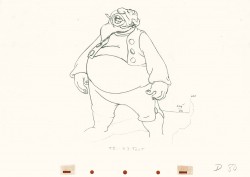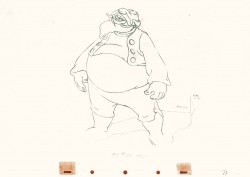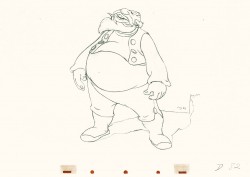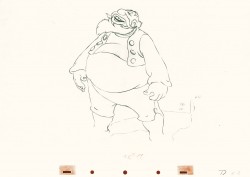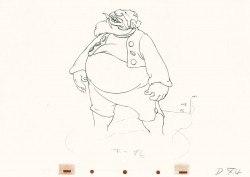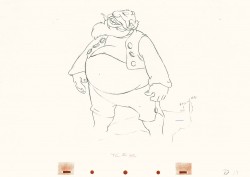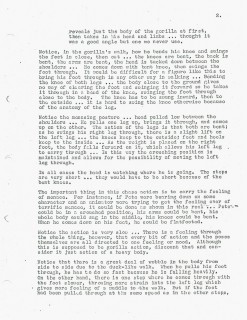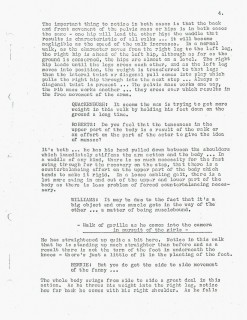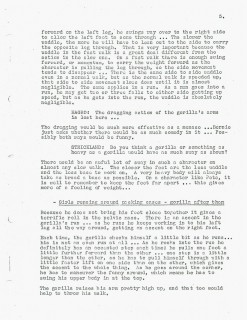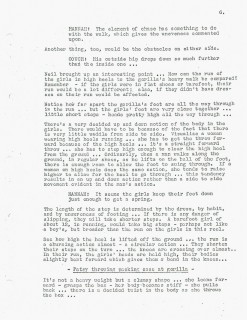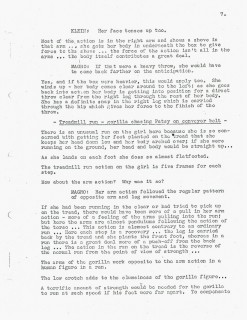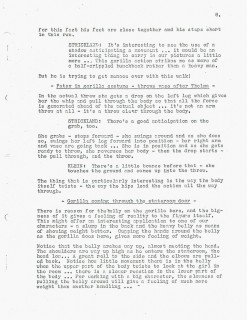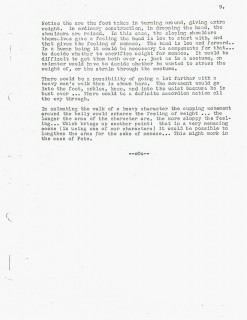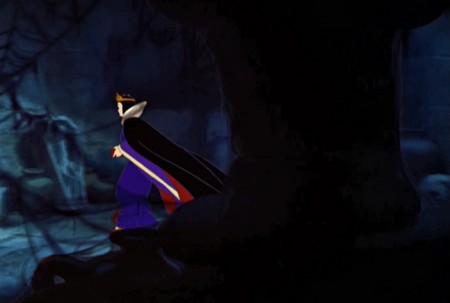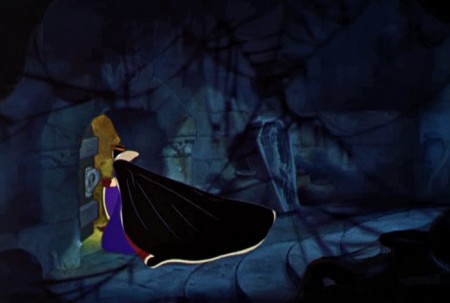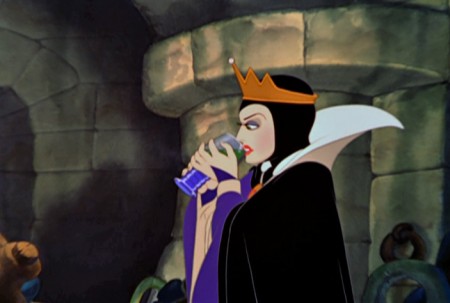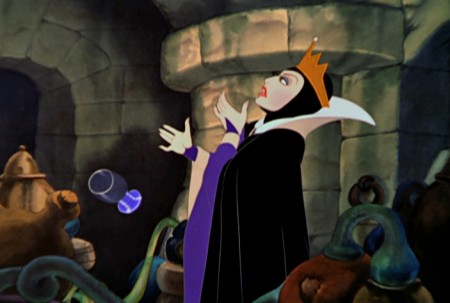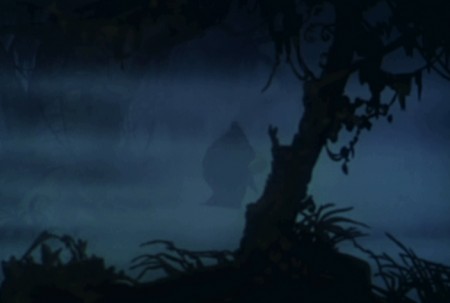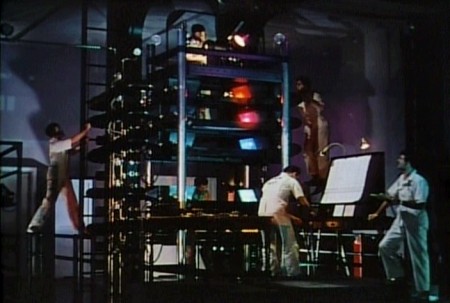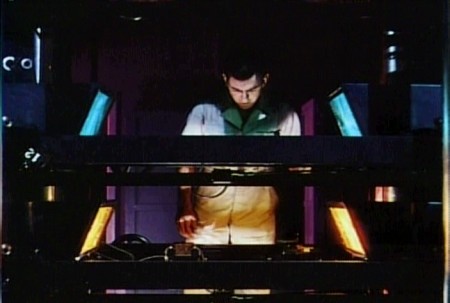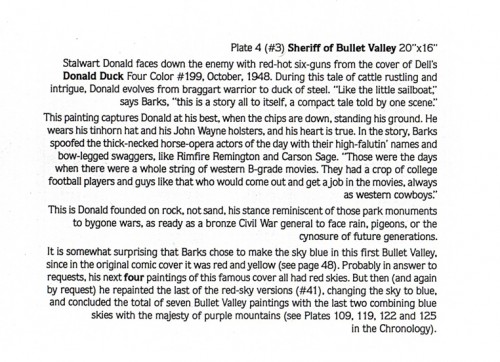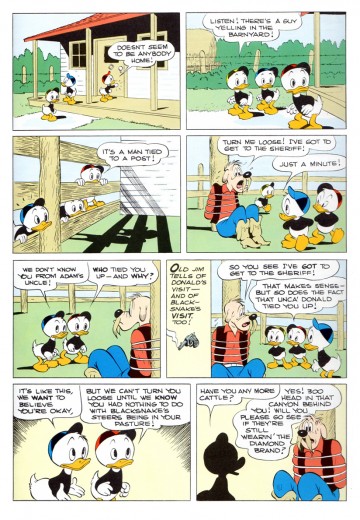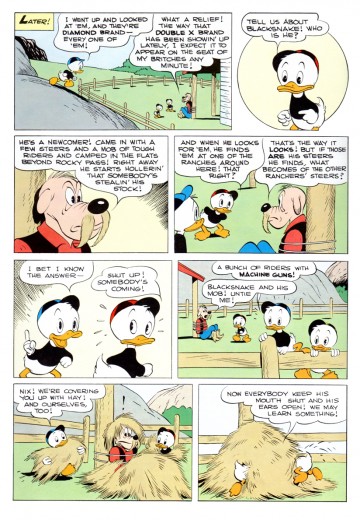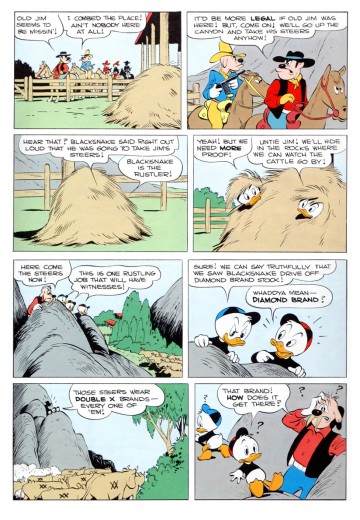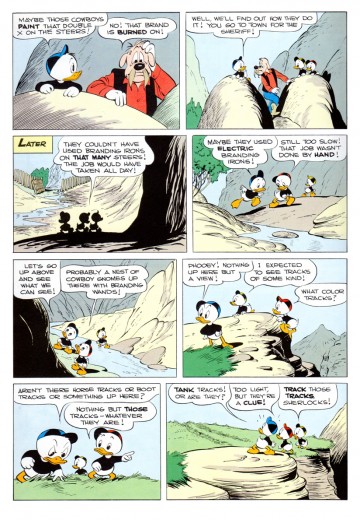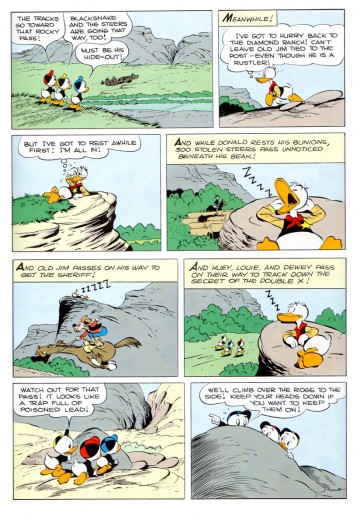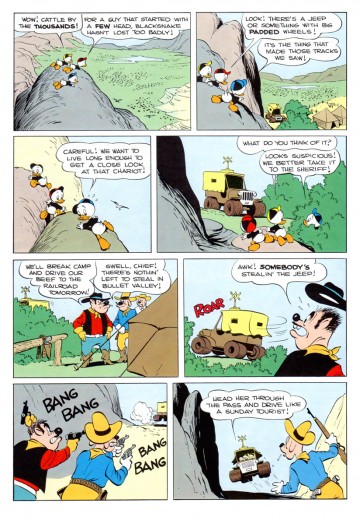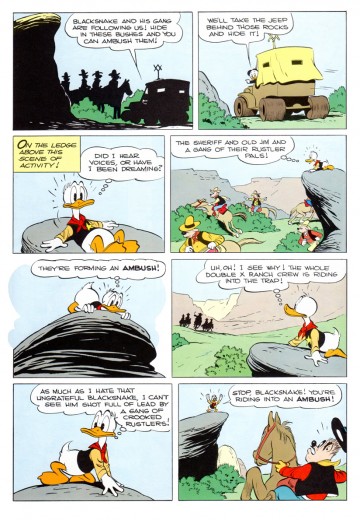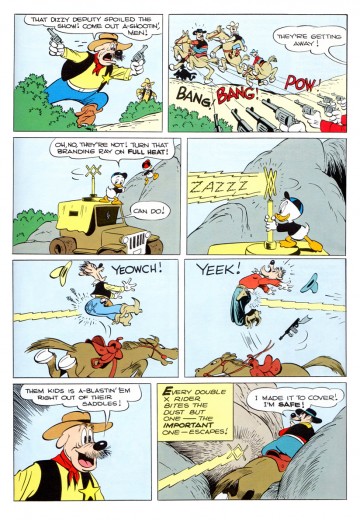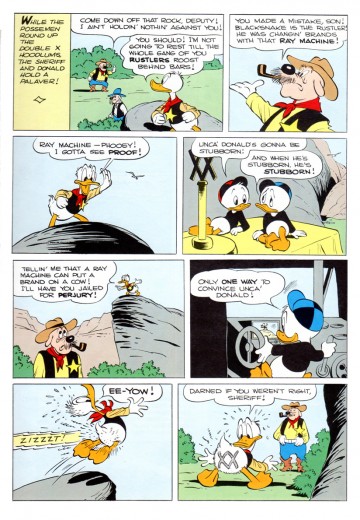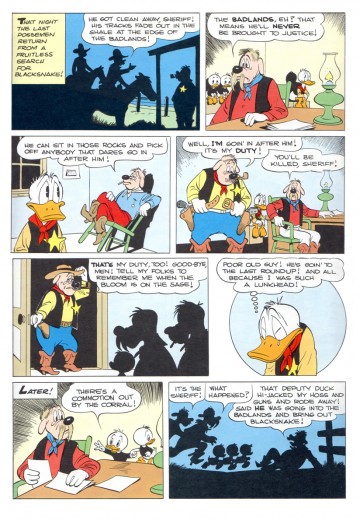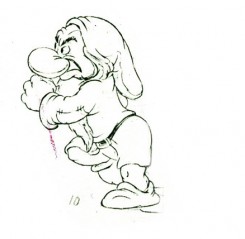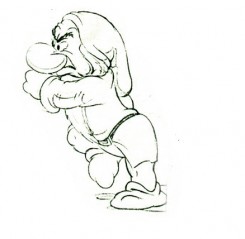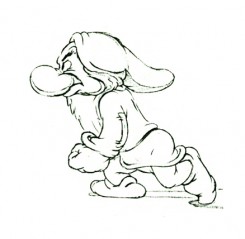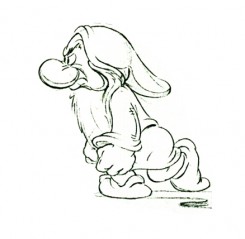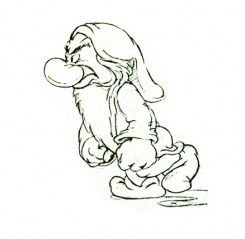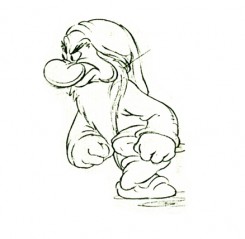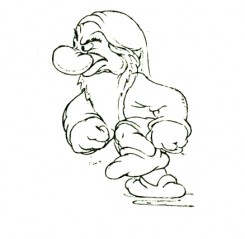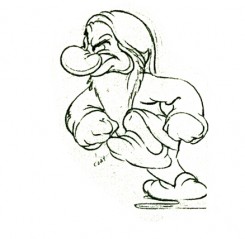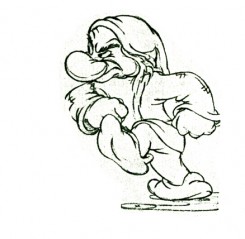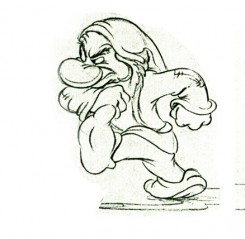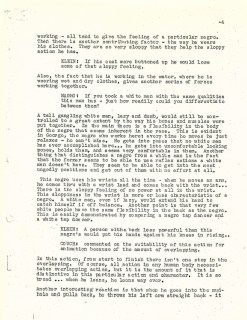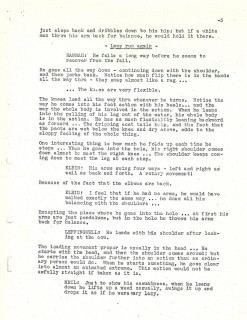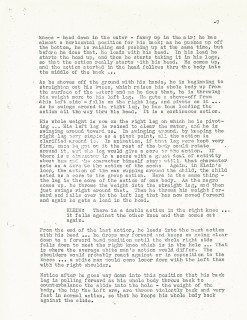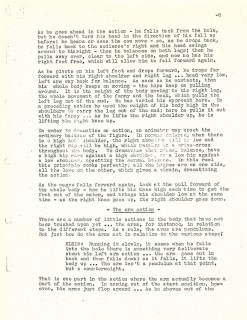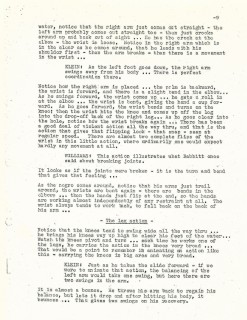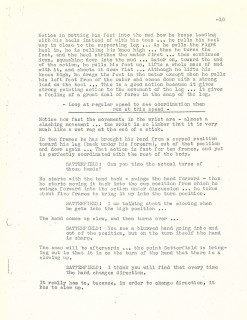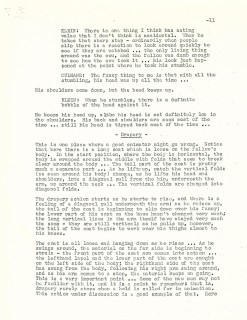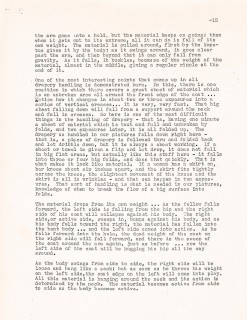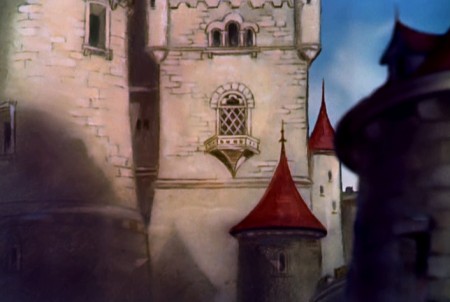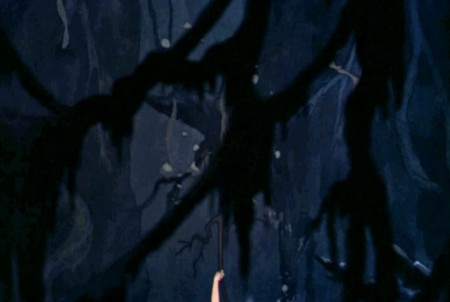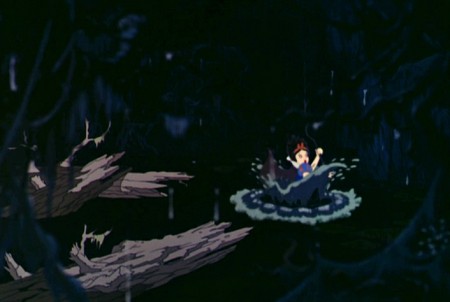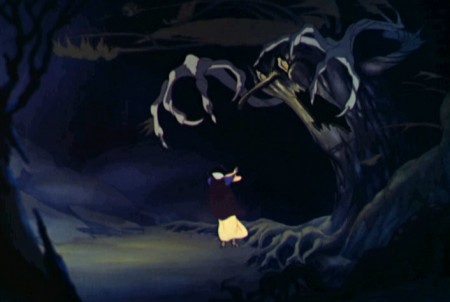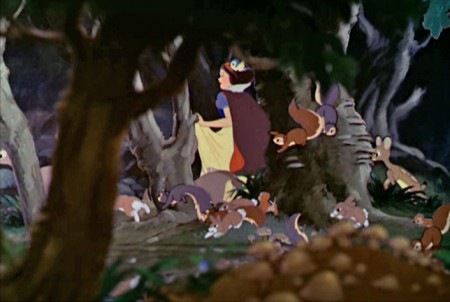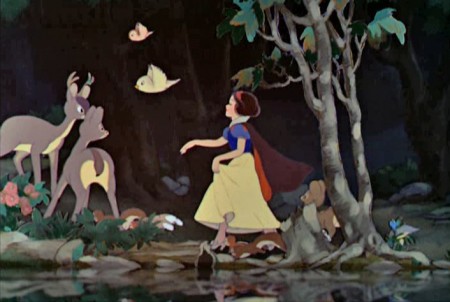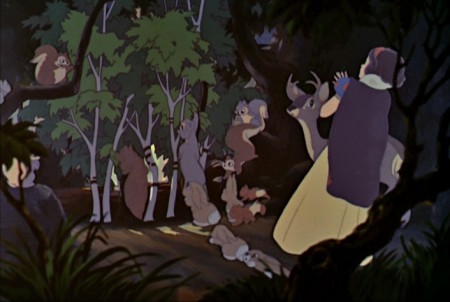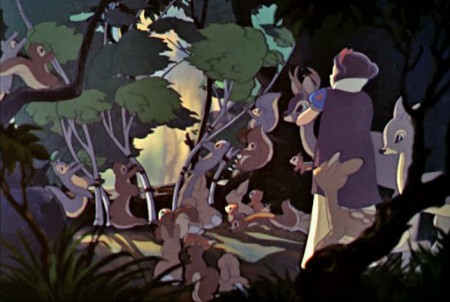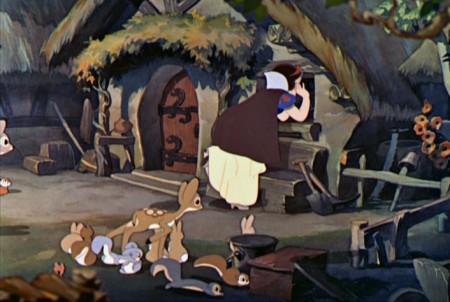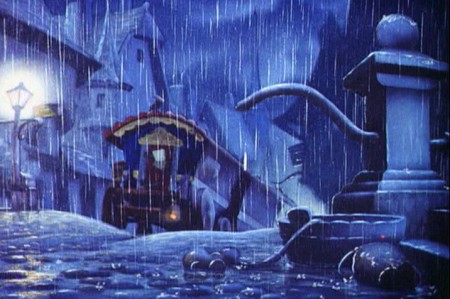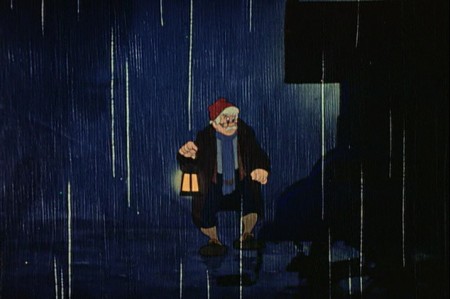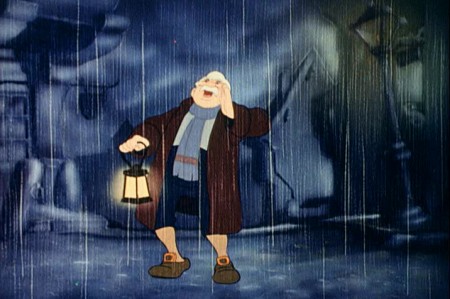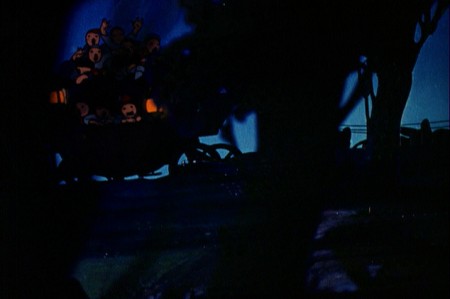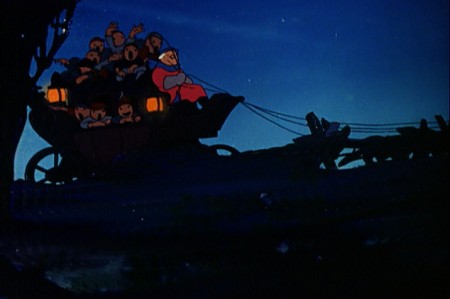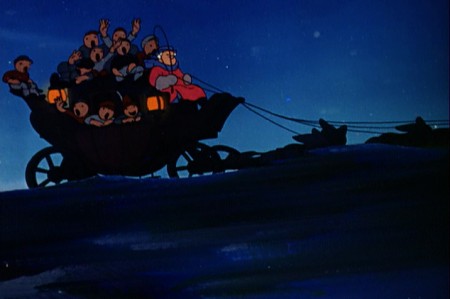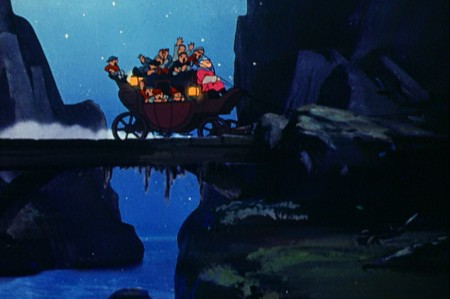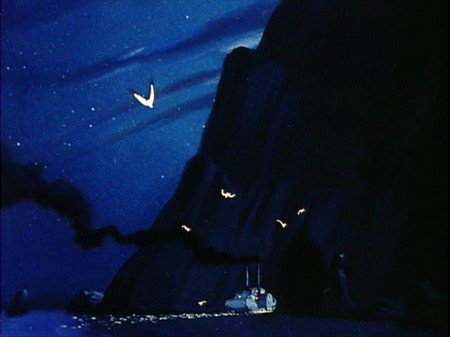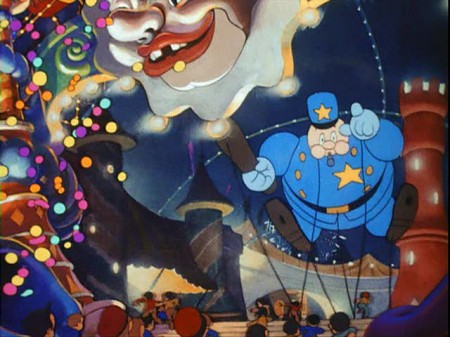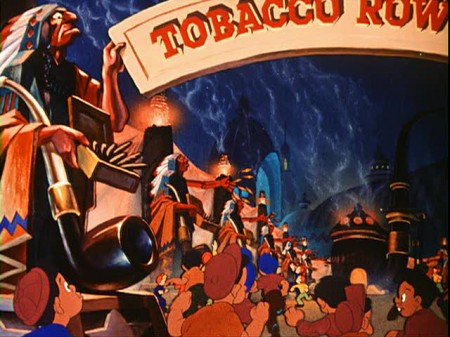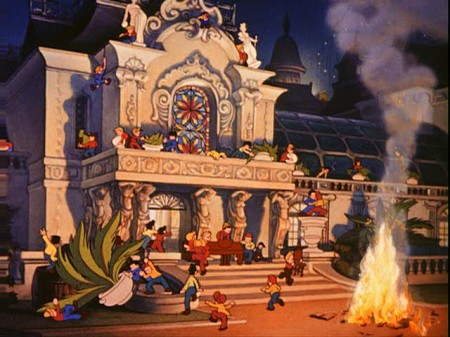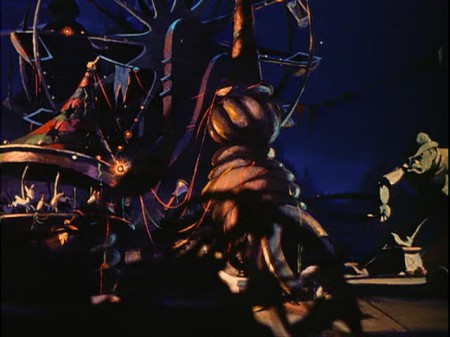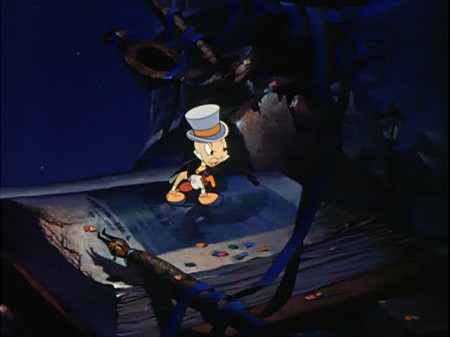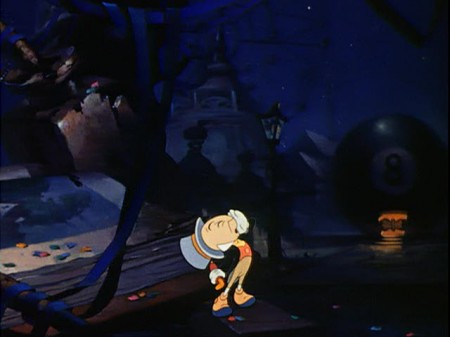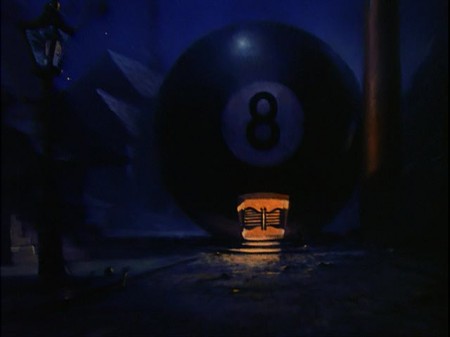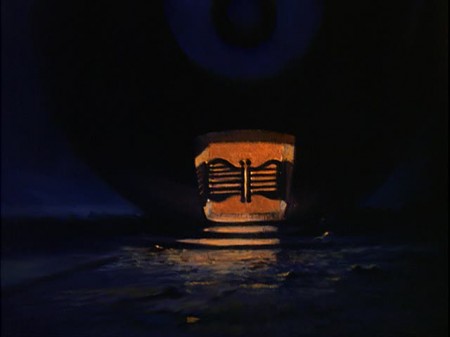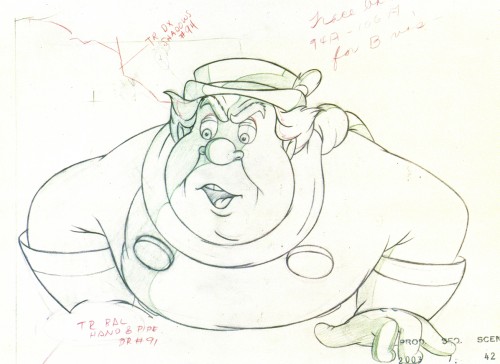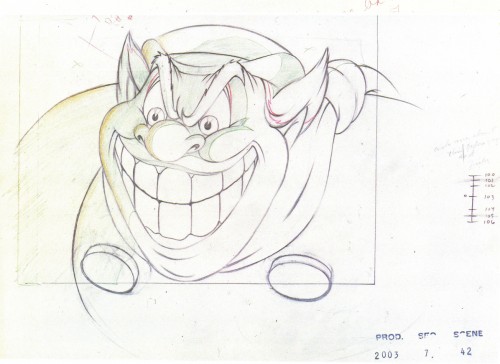Category ArchiveDisney
Animation &Animation Artifacts &Disney &John Canemaker &Tytla 21 Jul 2011 06:30 am
Tytla’s Stromboli – the Second half
This is a continuation of yeserday’s recap post. Tytla was a genius and this scene is proof. Originally in five parts, here are the final three.
Nancy Beiman brought to my attention that T.Hee did some live action reference for Tytla as Stromboli. Here are some stills I located:
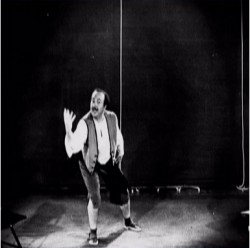
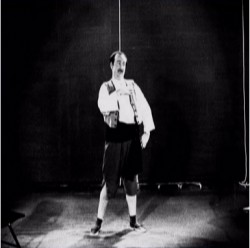
- This is part 3 of this large scene by Bill Tytla of Stromboli. The scene started in Part 1 with thoroughly frenetic anger from Stromboli. In Part 2 he tries to catch himself and get a grip on his emotions. Here in Part 3 he moves slowly and takes a 180° turn from where he started. The line against the curve. All this while playing out the lines from the scene. The drawing is stunning, the motion is brilliant, and the acting is the best animation has to offer. Those hands are just great; look at 126.
I pick up with the last drawing from Part 2.
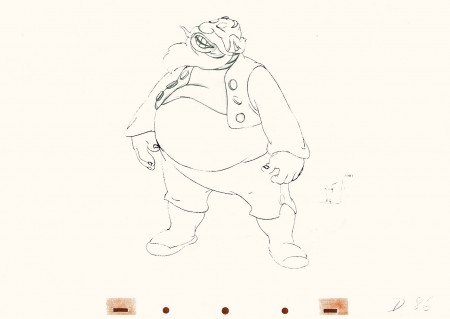 86
86(Click any image to enlarge.)
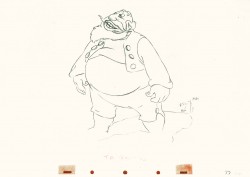 87
87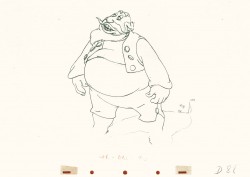 88
88
Tytla made sure he firmly planted Stromboli’s feet (in part 2)
before he attempted this firm bow.
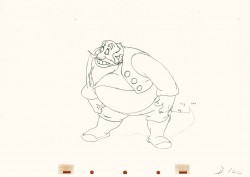
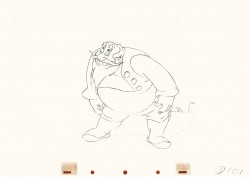 101
101
He’s made a solid line of the back, the strength of this move,
by using the left arm held firmly in place.
 102
102
This is the bottom of the bow, now he goes back up.

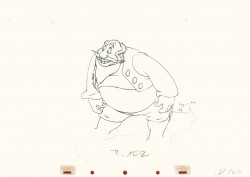 104
104
All of the shapes change naturally in the bow, though it looks
as if it remains a solid. No noticeable change. Solid weight.
 122
122
Watch the timing on the hand from here to #128
as Stromboli blows a kiss.
Many an animator today would pop it and call it animation.
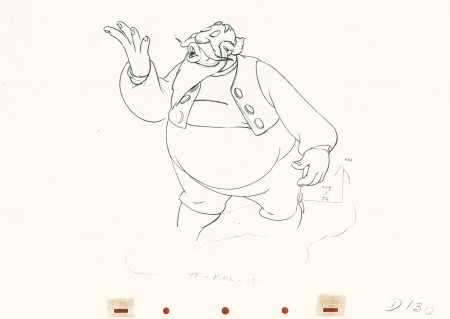 130
130
(Click any image to enlarge.)
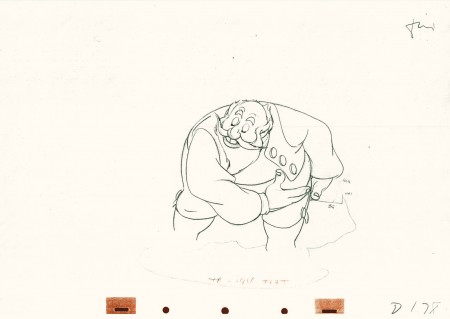 178
178
(Click any image to enlarge.)
Here’s the final QT of it all together:
Stromboli
Click left side of the black bar to play.
Right side to watch single frame.
David Nethery had taken my drawings posted and synched them up to the sound track here.
Animation &Animation Artifacts &Disney &John Canemaker &repeated posts &Tytla 20 Jul 2011 07:31 am
Tytla’s Stromboli – the First half
As stated last week, I’m recapping some of my Tytla posts from the past. This very long scene was originally in five parts. Today and tomorrow all five parts will be posted.
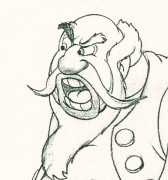 - Bill Tytla‘s work has to be studied and studied and studied for any student of animation. He was the best, and it’s pretty doubtful his work will be superceded. He brought beautiful distortion to many of the drawings he did, using it as a way to hammer home some of the emotions in the elasticity he was creating. Yet, the casual observer watching this sequence in motion doesn’t ever notice that distortion yet can feel it in the strength of the motion.
- Bill Tytla‘s work has to be studied and studied and studied for any student of animation. He was the best, and it’s pretty doubtful his work will be superceded. He brought beautiful distortion to many of the drawings he did, using it as a way to hammer home some of the emotions in the elasticity he was creating. Yet, the casual observer watching this sequence in motion doesn’t ever notice that distortion yet can feel it in the strength of the motion.
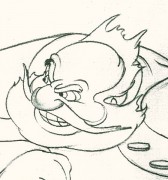
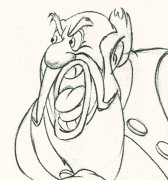
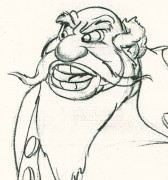
Four drawings (#1, 11, 22, & 48) that shift so enormously but call no attention to itself.
Brilliant draftsmanship and use of the forms.
Here we have the beginning: drawings 1-48. More will come in the future.
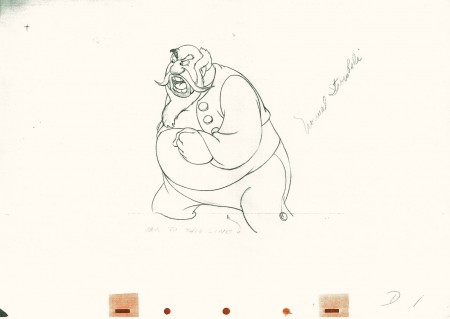 1
1(Click any image to enlarge.)
This note arrived from Borge Ring after my first post Bill Tytla’s scene featuring Stromboli’s mood swing:
- The Arch devotees of Milt Kahl have tearfull misgivings about Wladimir Tytla’s magnificent language of distortions. ‘”Yes, he IS good. But he has made SO many ugly drawings”
Musicologists will know that Beethoven abhorred the music of Johan Sebastian Bach.
yukyuk
Børge
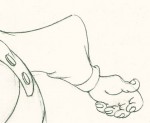
My first post spoke a bit about the distortion Tytla would use to his advantage to get an emotional gesture across. It’s part of the “animating forces instead of forms†method that Tytla used. This is found in Stromboli’s face in the first post. In this one look for this arm in drawing #50. It barely registers but gives strength to the arm move before it as his blouse follows through in extreme.
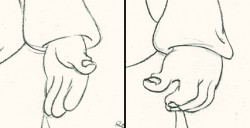 There’s also some beautiful and simple drawing throughout this piece. Stromboli is, basically, a cartoon character that caricatures reality beautifully. A predecessor to Cruella de Vil. In drawings 76 to 80 there’s a simple turn of the hand that is nicely done by some assistant. A little thing among so much bravura animation.
There’s also some beautiful and simple drawing throughout this piece. Stromboli is, basically, a cartoon character that caricatures reality beautifully. A predecessor to Cruella de Vil. In drawings 76 to 80 there’s a simple turn of the hand that is nicely done by some assistant. A little thing among so much bravura animation.
Many people don’t like the exaggerated motion of Stromboli. However, I think it’s perfectly right for the character. He’s Italian – prone to big movements. He’s a performer who, like many actors in real life, goes for the big gesture. In short his character is all there – garlic breath and all. It’s not cliched and it’s well felt and thought out. Think of the Devil in “Night on Bald Mountain” that would follow, then the simply wonderful and understated Dumbo who would follow that. Tytla was a versatile master.
Here’s part 2 of the scene:
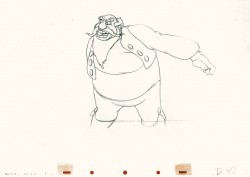 48
48 49
49(Click any image to enlarge.) The full scene with all drawings.
Click left side of the black bar to play.
Right side to watch single frame.
David Nethery had taken my drawings posted and synched them up to the sound track here.
Action Analysis &Animation Artifacts &Disney 19 Jul 2011 07:00 am
Action Analysis – April 5, 1937
- We’re taking a step back before we go forward. Last week I posted the April 12th, 1937 edition of the Action Analysis notes from the Disney studio’s after hours class. I had to skip the April 5th notes because all I really had was the cover page. The actual notes weren’t included. Mike Barrier to the rescue. He sent me the correct notes for April 5th, and I’m now able to post them here.
Don Graham conducts the session which includes some footage from “Bum Voyage” starring Thelma Todd and Patsy Kelly. This is a 1934 feature from MGM and Hal Roach Studio. A madcap sequence which shows Thelma being chased by Patsy in a Gorilla outfit. Unfortunately, Netflix doesn’t seem to have this film, nor has TCM issued a dvd, as yet.
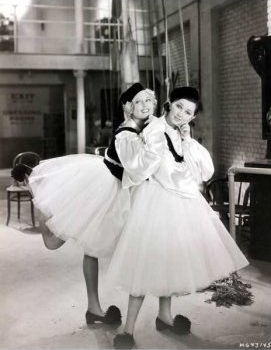
Mark Sonntag directed me to this great still
from “Bum Voyage” for sale on ebay.
Those who participate in the lecture include: Izzy Klein, Bernie Wolf, Joe Magro, Roy Williams, Eddie Strickland, Stan Quackenbush, Jacques Roberts, Chuck Couch and Jack Hannah.
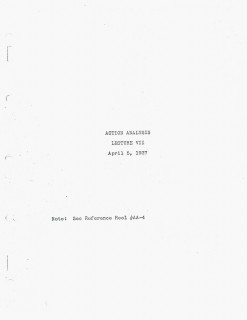
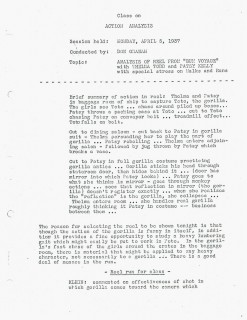 1
1
Disney &Frame Grabs 18 Jul 2011 07:12 am
Snow White Multiplane – 2
- Once Snow Whtie enters the dwarfs’ home, the multiplane camera virtually gets into limited use. There are almost no interior multiplane shots in the film, and few exteriors in the second half of the movie. I have collected a few, and I’ll post them here. Like the first half of the movie, the multiplane shots do not call attention to themselves. They’re in no way obvious, but they do help set a texture and a mood throughout the film.
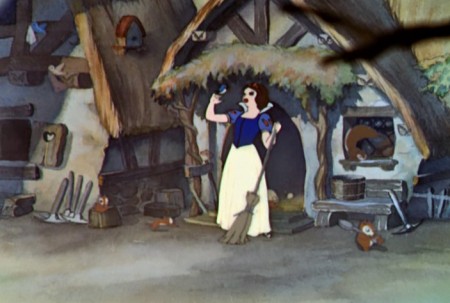 1a
1aThe first scene to use the multiplane after “Whistle While You Work,”
comes at the end of the sequence when the camera pulls out from the
cottage and Snow White has finished her work.
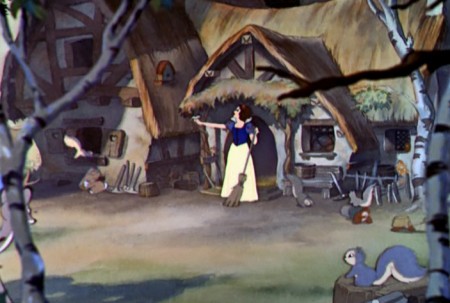 1b
1b
As we pull out, overlays, slightly out of focus, come into the picture . .
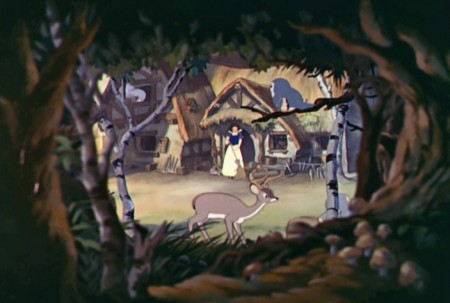 1c
1c
. . . until the camera comes to a stop.
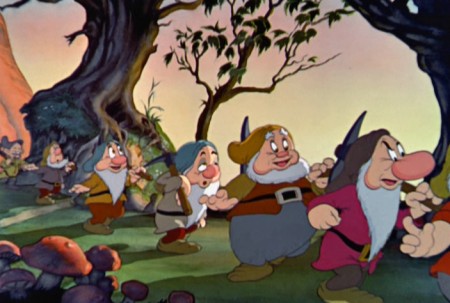 2a
2a
We see the next use of the camera when the dwarfs
go home from the mine.
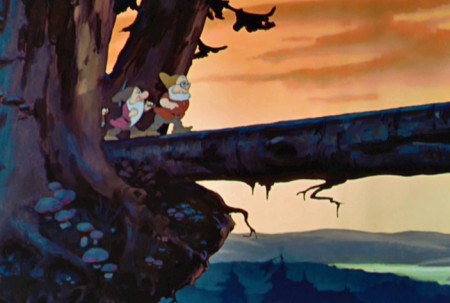 3a
3a
It’s the famous scene where all seven dwarfs
march across the tree-bridge.
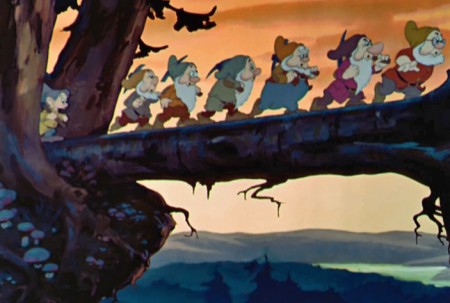 3b
3b
The sky is separated from the foreground elements . . .
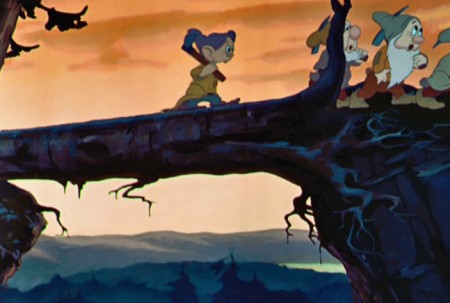 3c
3c
. . . as the camera moves in a bit.
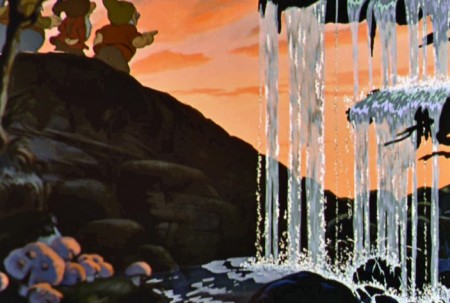 4a
4a
Likewise the following scene where the dwarfs
move home behingd the water fall.
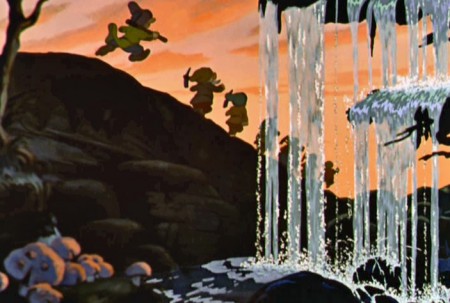 4b
4b
There’s a arge separation between background and foreground.
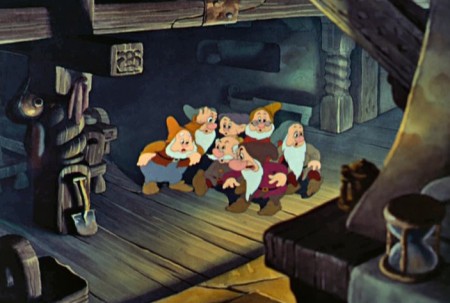 5a
5a
There is an interior shot where the dwarfs search for Snow White.
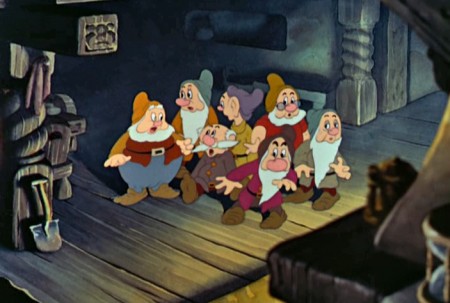 5b
5b
The camera trucks in to the dwarfs
while foreground objects go out of focus.
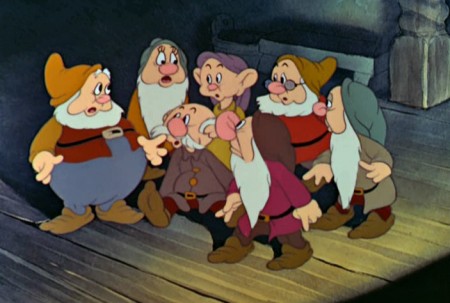 5c
5c
Not all of the dwarf drawings are beautiful.
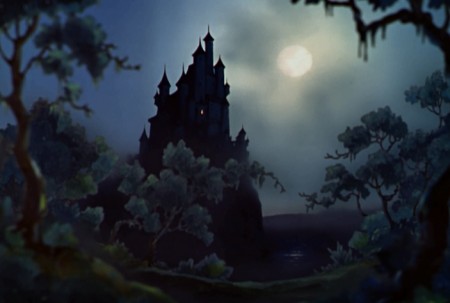 6a
6a
The truck in to the castle is stunningly beautiful.
 6b
6b
Traditionally, the moon stays its size
while other things move to the camera.
 7a
7a
Dissolve to a closer shot of the castle and the moon . . .
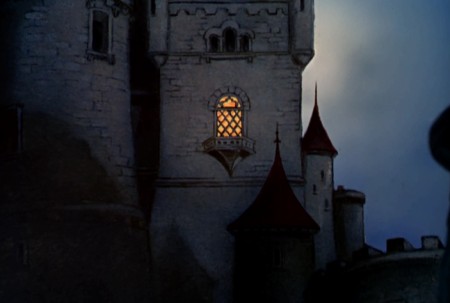 7b
7b
. . . the camera continues to move in.
 8a
8a
The Queen comes down the stone stairs.
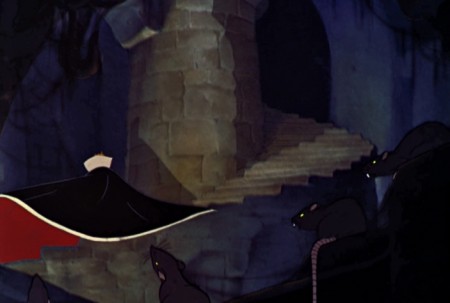 8b
8b
She continues to screen left.
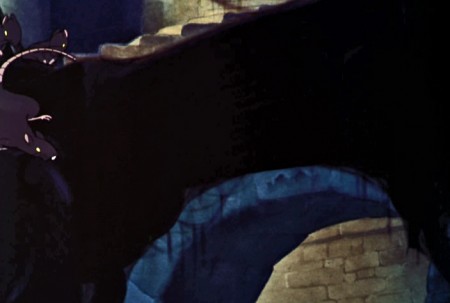 8c
8c
The camera pans down to the bottom of the stairs.
An overbridge passes the frame.
 8d
8d
She continues on with all determination, behind chains.
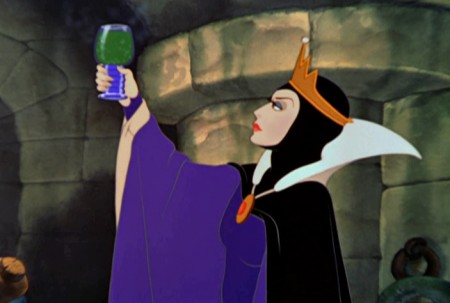 9a
9a
MS, the Queen raises her glass of toxins . . .
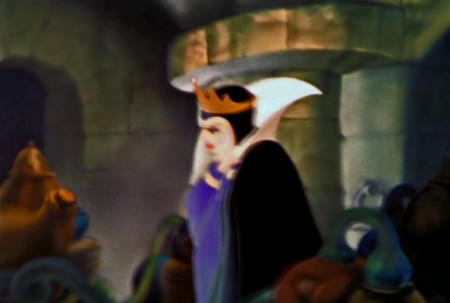 9d
9d
We lose focus on the Queen.
 9e
9e
The room spins around as the montage begins.
Forground objects swirl in front of the Queen.
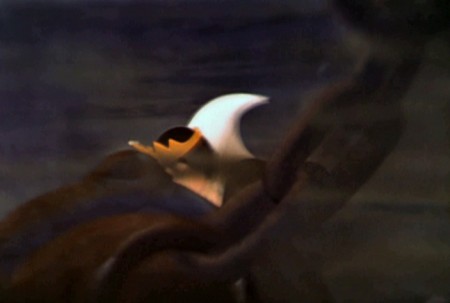 9f
9f
We end with a slip of the Queen, wildly out of focus.
 10a
10a
The animals watch the celebration going on in the dwarfs’ cottage.
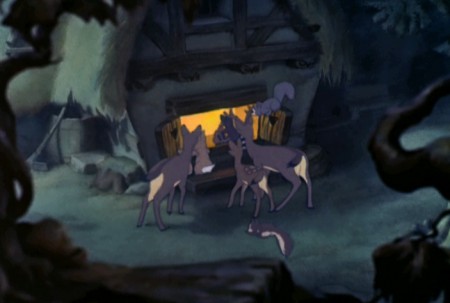 10b
10b
The camera pulls out giving levels for the multiplane camera.
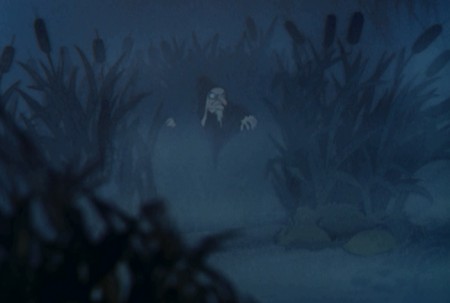 11a
11a
One of my favorite shots has the old hag coming out of the fog.
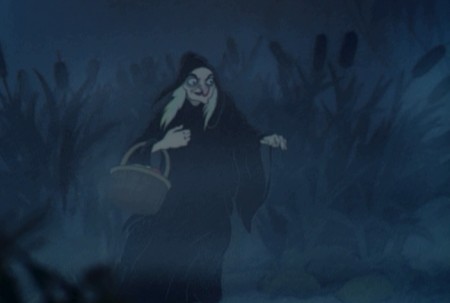 11b
11b
She grows larger as she moves to the foreground.
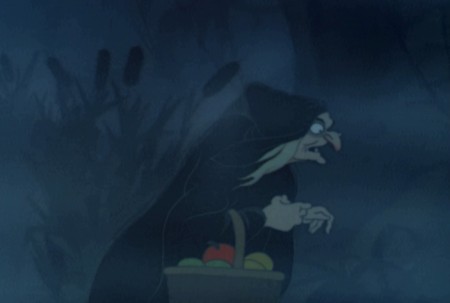 11c
11c
She turns and moves across the screen.
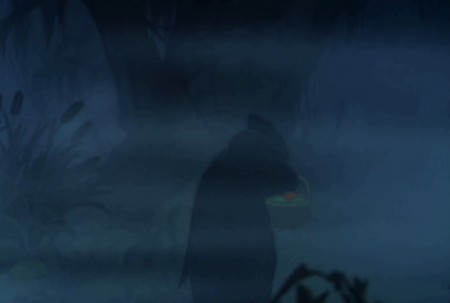 11d
11d
She urns her back to us . . .
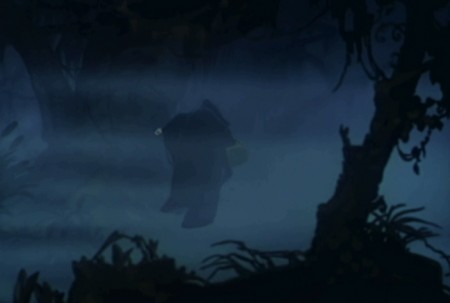 11e
11e
. . . and moves into the distance.
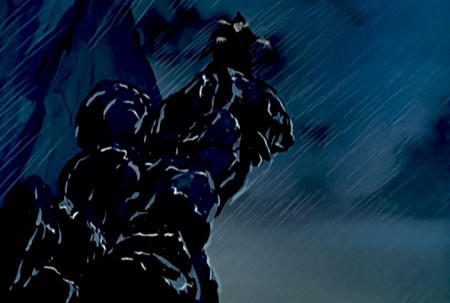 12a
12a
At the top of the cliff in the rain clouds move on another plane.
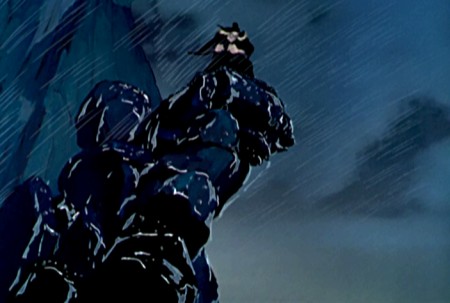 12b
12b
The camera moves in as the clouds continue to speed by.
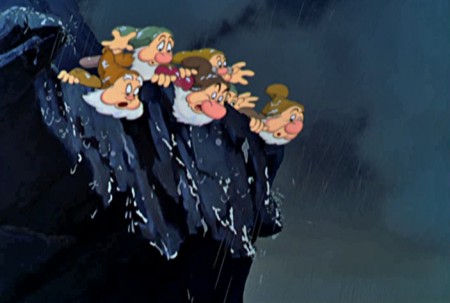 13
13
After she falls, the dwarfs look down to her.
This is the last multiplane shot in the film.
Bill Peckmann &Comic Art &Disney 15 Jul 2011 06:59 am
Sheriff of Bullet Valley – 2
- Today we continue with part 2 of 3 from Carl Barks‘ brilliant comic story, “Sheriff of Bullet Valley.” Bill Peckmann who sent the whole thing to me for posting, starts with an oil painting by Barks which was based on this story. Bill writes:
- Here’s Carl’s painting of the cover (caption to follow). It’s taken from “The Fine Art of Walt Disney’s Donald Duck” by Carl Barks. It was published in 1981 by Another Rainbow Publishing Co.
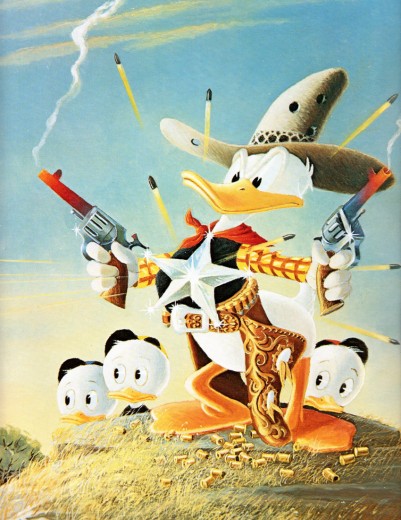
“The Sheriff of Bullet Valley”
Bill Peckmann wrote:
- Fortunately for us, “Bullet Valley” broke down nicely into 3 acts, but then again with the ol’ master, Carl Barks, at the helm, I’m sure luck had nothing to do with it.
One more note on the coloring. After rummaging through other colored reprinted (and original) versions of BV, I’ve come to the conclusion (IMHO) that this might be one of the best colored Barks story ever. I wish I knew who did the art direction on the the coloring, great job. Usually the colors are all slightly over saturated or are computer gradated, this version has all of the colors done nicely in a simple pale mode and boy, does that let Barks’ line work (one of the best in the business) superbly shine through!
Animation &Animation Artifacts &Disney 14 Jul 2011 07:18 am
Dwarf walk – recap
As I noted on Saturday last, I have a wealth of Bill Tytla animation on the past of this blog and I think it’s time to bring it forward for a recap. The stuff is too good and deserves more than a little study for ANYONE who calls himself an animator. This piece was originally posted in August 2009.
- Here are the drawings of Grumpy walking in a huff. Bill Tytla was the animator. The images come from a photostat which prepared the material for publication. A couple of these drawings appeared in the Thomas-Johnston book, Illusion of Life. The sequence, here, is missing drawing numbers 6,7 and 8.)
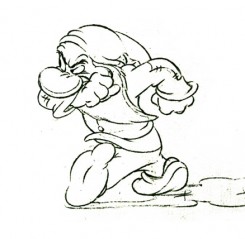 1
1  2
2Note how he starts with his shoulders high.
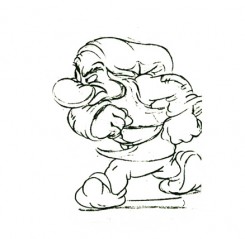 3
3 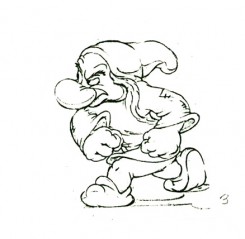 4
4
His bent leg, at this point, takes the weight of his body.
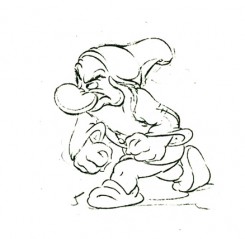 5
5 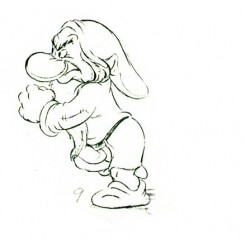 9
9
He moves his body up, high . . .
(Note that we’re missing drawings 6, 7, and 8.)
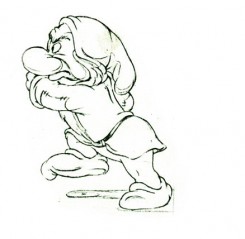 12
12 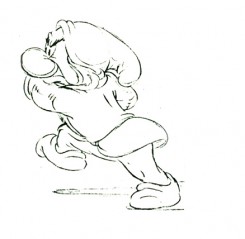 13
13
. . . then twists his entire torso.
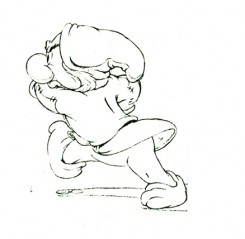 14
14 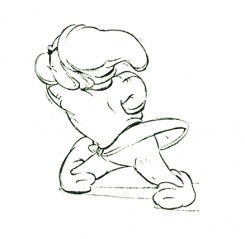 15
15
The straightened leg makes contact.
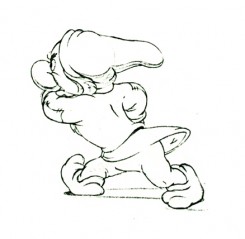 16
16 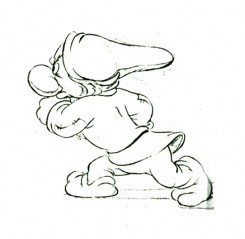 17
17
Again the shoulders go high as the pattern repeats on the other leg.
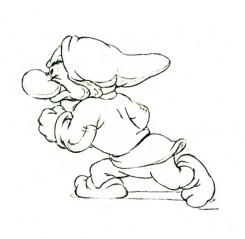 18
18 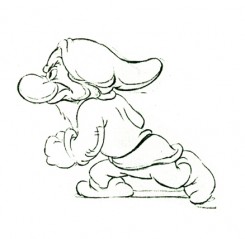 19
19
Note the detailed attention to the flow of the clothing throughout.
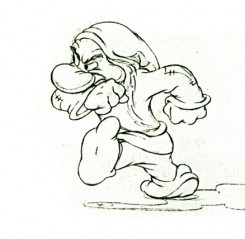 28
28
(Click any of the above images to enlarge.)
The following QT movie is on one’s with
the exception of dwngs #5, 9, & 11 on twos
to make up for the three missing drawings.
Right side to watch single frame.
Animation &Animation Artifacts &Disney &Tytla 13 Jul 2011 06:50 am
Tytla’s Dwarf Fight – recap
As I noted last Saturday, I intend to repost a number of the Bill Tytla animated pieces I have in the history of this blog. His work, at least to me, is too important to let just sit there. This post was originally published on this blog in March 2009.
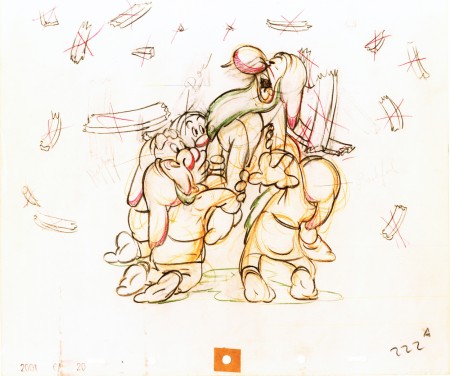
Here is a scene from Snow White, animated by Bill Tytla, in which four of the dwarfs fight Grumpy. The drawing above is the first of these drawings and it shows what it looked like in color – lots of red pencil notes, yellow pencil for rough structural lines. The rest of the drawings I have are B&W copies.
One of the things about Tytla’s work that I just love is the built in distortion he does to the characters. Check out Happy’s face (upper left) in drawing #227. Or Grumpy’s face in #260. They’re beautiful, and when the animation is moving, the distortion doesn’t show. He did as much with Stromboli. I’m convinced this is one of the ways he pulled the inner character out, trying to get Stanislavski’s theories into animation. It’s wonderful.
By the way, if you like this material check out Hans Perk ‘s site. Tytla talks about dealing with forces vs. forms in animation. This is what Tytla was all about in animating.
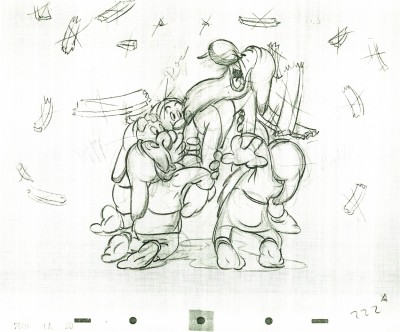 222
222(Click any image to enlarge.)
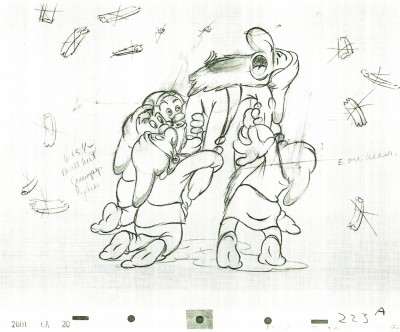 223
223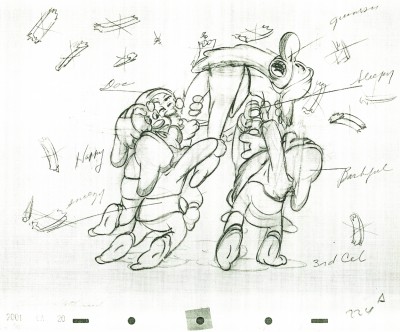 224
224 225
225 226
226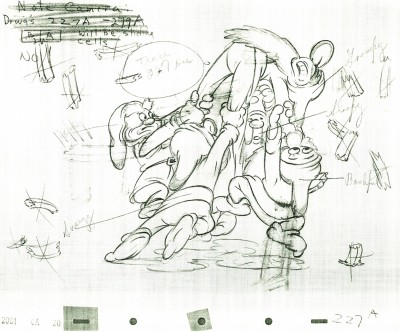 227
227Check out Happy’s face on this inbetween.
Then check out Tytla’s drawing (the next one) of Happy.
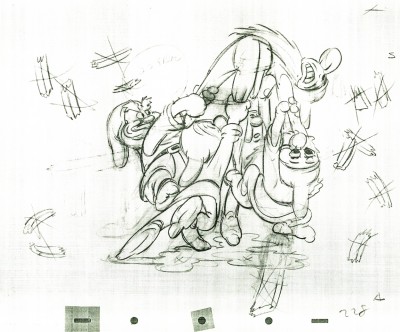 228
228
Tytla marked his own drawings with an “X” in the upper right corner.
The other drawings are the work of inbetweeners. The writing looks
to be all the work of Tytla.
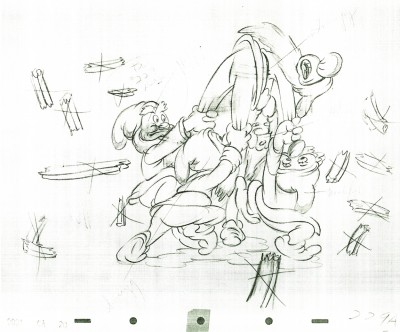 229
229
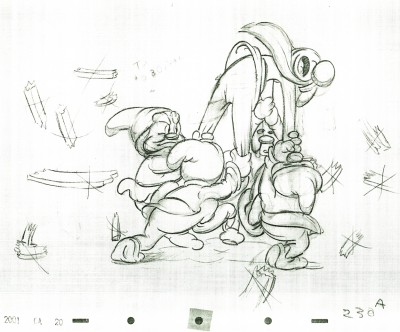 230
230
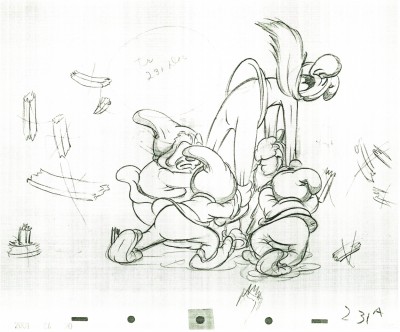 231
231
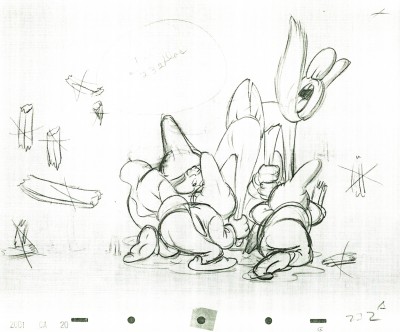 232
232
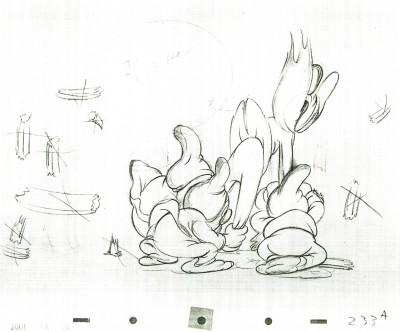 233
233
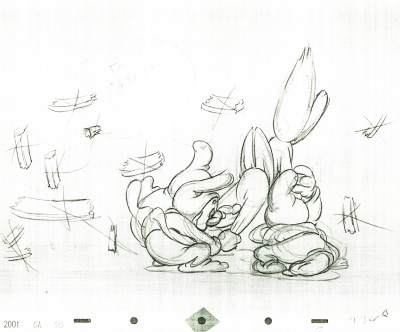 234
234
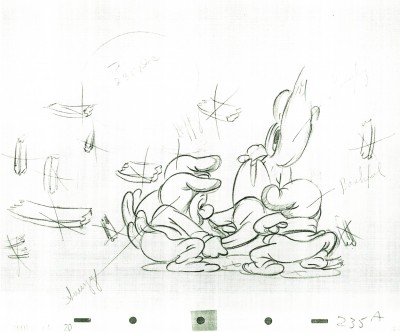 235
235
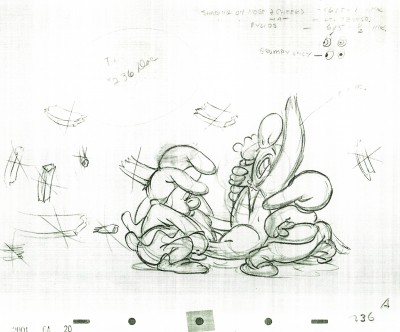 236
236
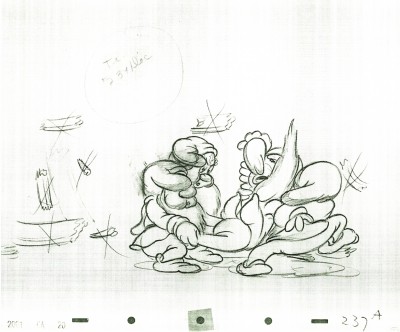 237
237
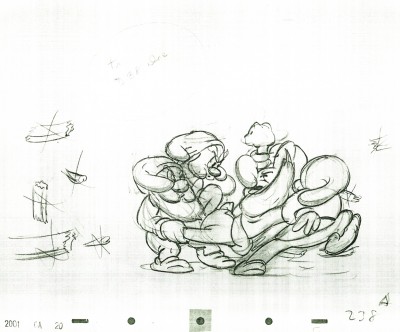 238
238
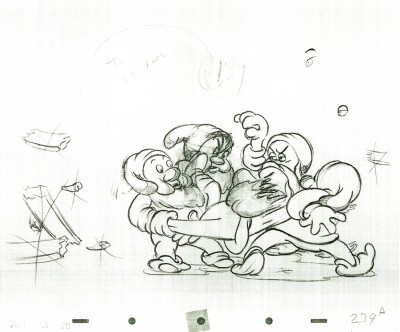 239
239
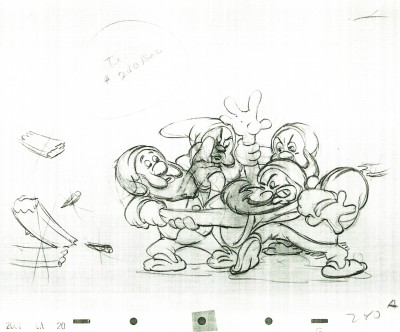 240
240
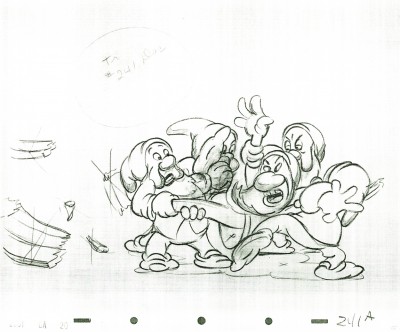 241
241
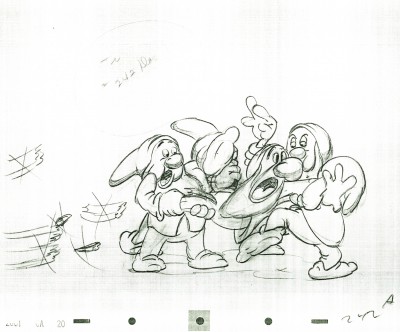 242
242
Some of these drawings are just hilarious in their own right.
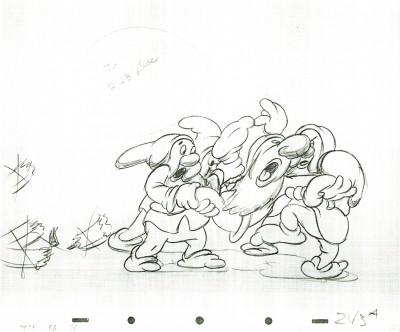 243
243
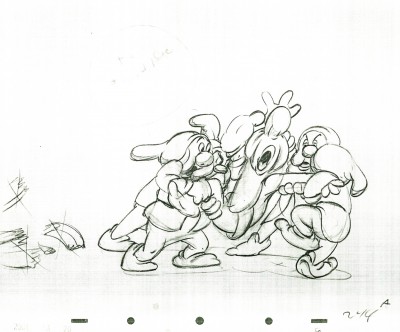 244
244
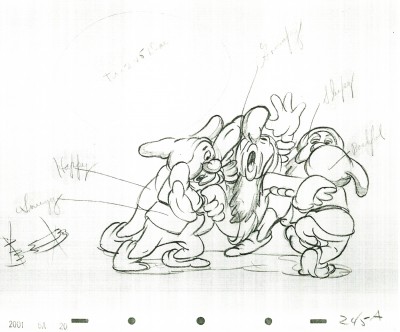 245
245
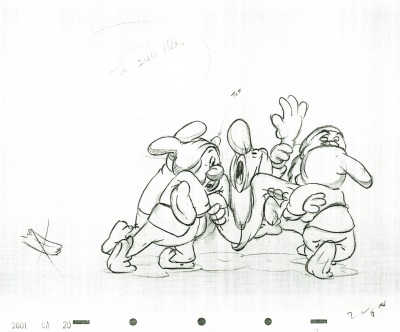 246
246
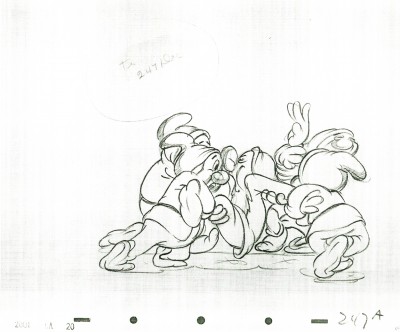 247
247
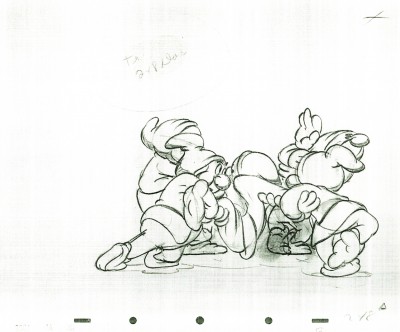 248
248
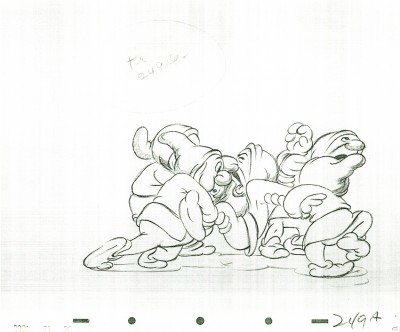 249
249
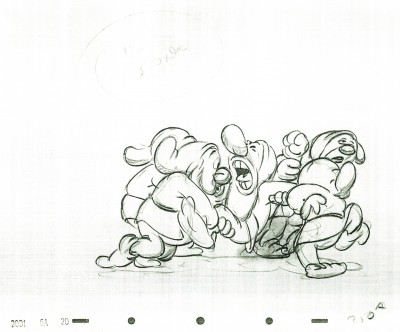 250
250
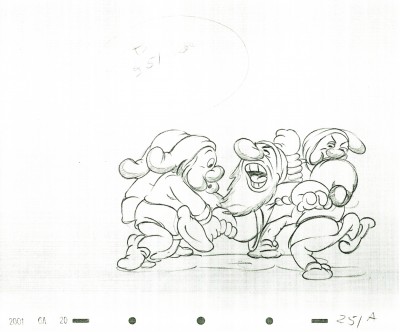 251
251
 252
252
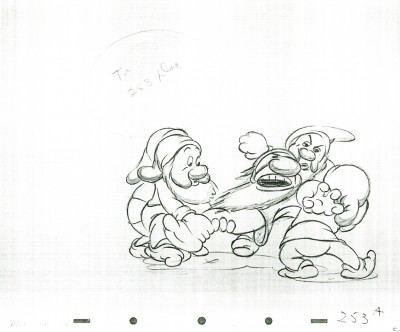 253
253
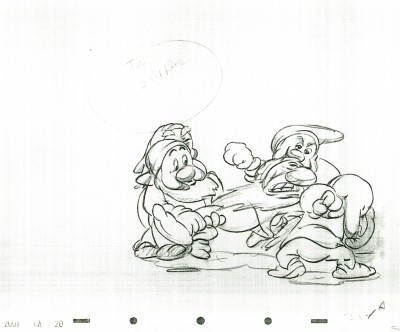 254
254
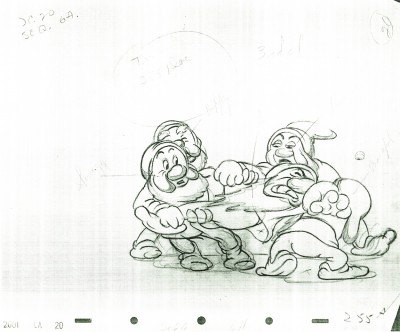 255
255
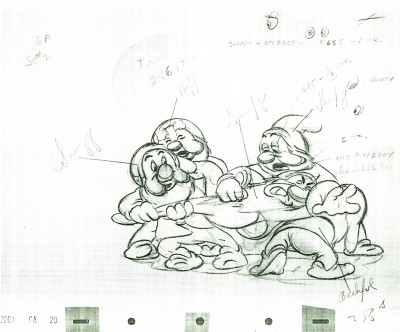 256
256
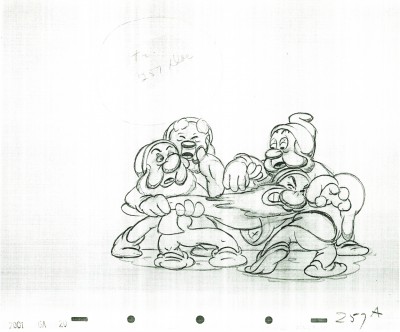 257
257
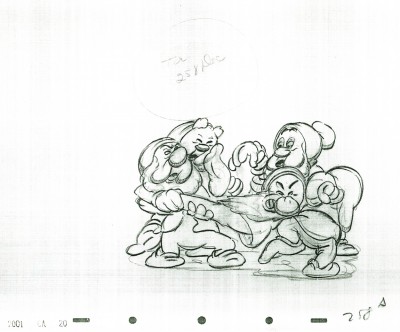 258
258
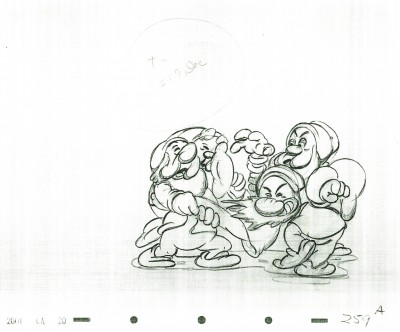 259
259
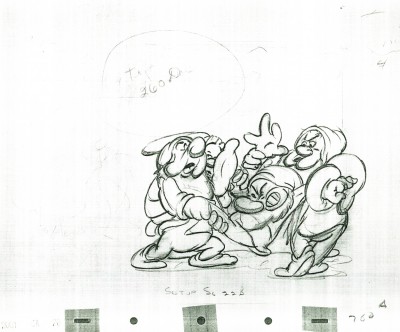 260
260
Action Analysis &Animation Artifacts &Articles on Animation &Disney 12 Jul 2011 06:46 am
Action Analysis – April 12, 1937
- Onto the next week’s class of Action Analysis at the Disney Studio, after hours. Actually, I’ve skipped a week. I only have four pages of the notes from the April 6 1937 class. Since it is missing a dozen pages, I’m not sure how worthwhile it’d be to post it. So I’ve skipped to this very full session.
Don Graham teaches. The film they study shows a 12 ft. (8 secs.) bit of a man picking himself up from mud – dragging and wading through mud. (It’s a little embarrassing posting this which actually reads: “Loop of young negro picking himself up from mud . . . Those were the days of feckless, racist behavior.) Obviously, we can’t see the footage (which is probably still somewhere in the Disney vaults), but we can pick up lots of information from the lesson.
The attendees who participate include: Jack Hannah, John Vincent Snyder, David Rose, Izzie Klein, Joe Magro, Chuck Couch, Robert Leffingwell, Milt Neil, Roy Williams, and Paul Satterfield.
Read on.
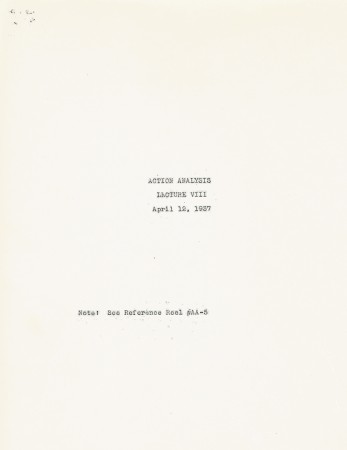
Title page
Disney &Frame Grabs 11 Jul 2011 06:43 am
Snow White Multiplane – 1
- The first feature Disney used to display his multiplane camera was his first feature, Snow White. Interestingly enough, I find the use of the camera in this first feature film to be one of the least ostentatious of them all. Any displays of depth or multiplane pans are almost hidden in the movie, as if they didn’t want to call attention to themselves. This, of course, is the exact opposite of its use in Pinocchio.
However, there are a lot of scenes that use it to hide or help effects for the film.
I’ve captured a lot of demonstrations of the camera in use and will start displaying them from the beginning of the film.
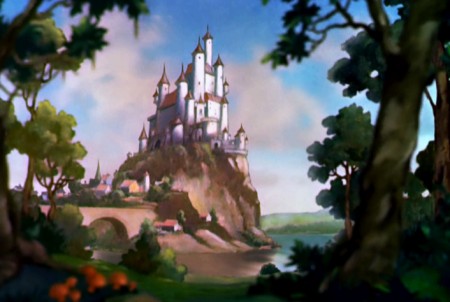 1a
1aThe film starts off using the multiplane with the first two shots.
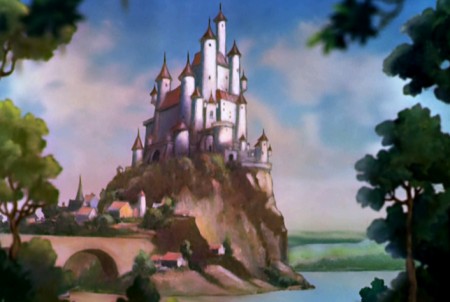 1b
1b
As we truck in on the castle, there are slight changes of focus on overlays.
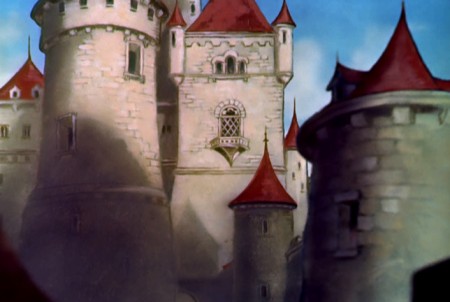 2a
2a
The same goes for this second shot.
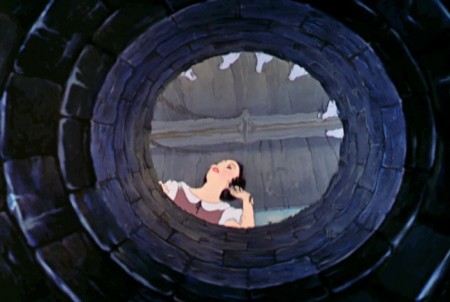 3a
3a
In the wishing well, the brick work is broken into a number of different levels.
The top two are progressively out of focus even though there is no camera move.
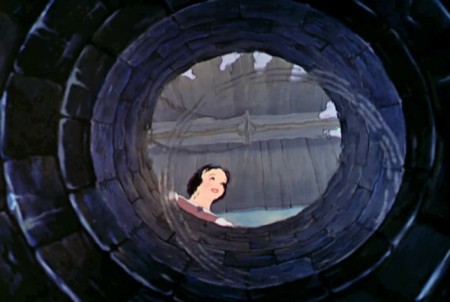 3b
3b
This makes the ripples and the reflection easier to produce
keeping everything else in the same level of focus.
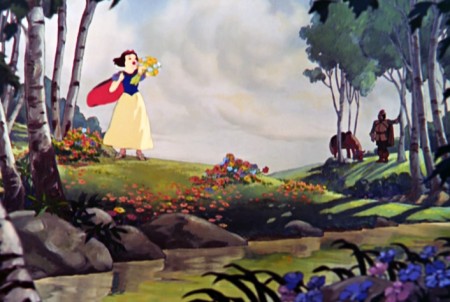 4a
4a
Once the woodsman takes Snow White to the forest, the camera
comes into its own – although they still use it with great subtlety.
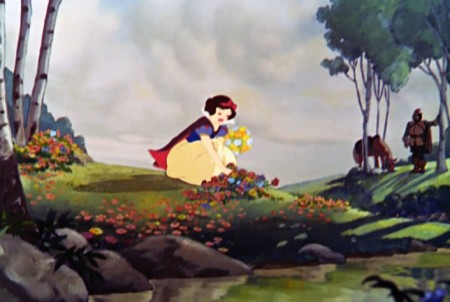 4b
4b
As the camera moves in there’s a rack focus on all the levels.
 4c
4c
The grassy hill that SW stands on moves separately from the sky.
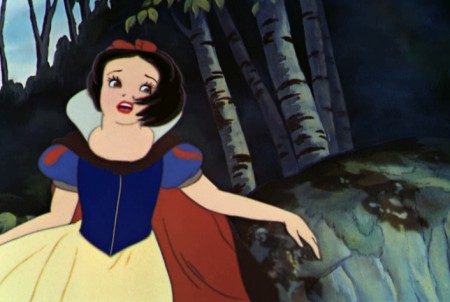 5a
5a
And once the hunter tells her to run away there’s plenty of movement.
Here, she starts backing away from the hunter.
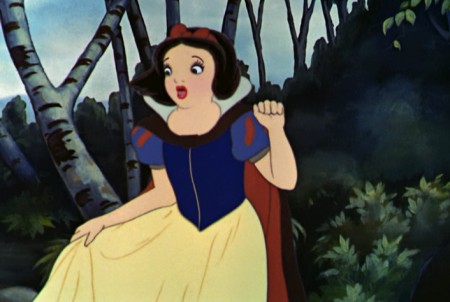 5b
5b
She continues to back away. Levels start moving behind her.
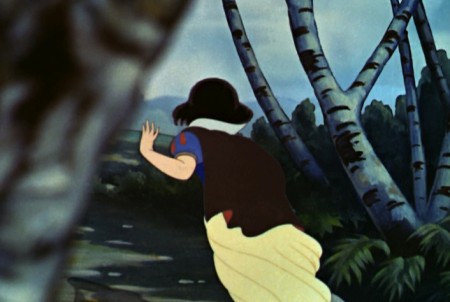 5c
5c
Once she starts running a large out of focus tree sweeps across the screen.
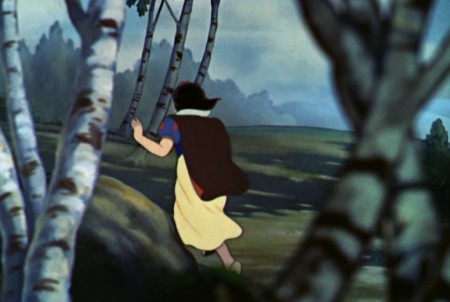 5d
5d
She moves into the perspective as the trees swoop past her.
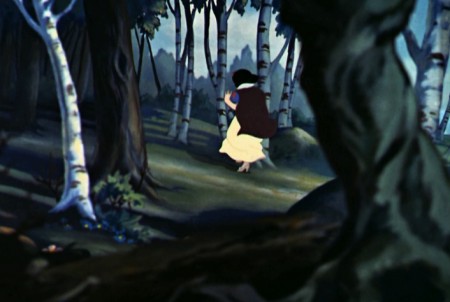 5e
5e
She runs toward a block of trees.
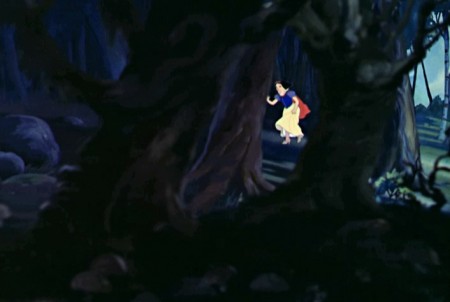 5f
5f
We see her continue past the group of trees into the darkness.
At times she’s completely shaded by the out of focus trees.
 6a
6a
She turns and backs slowly into the forest . . .
 6b
6b
. . . and falls into a hole.
 6c
6c
The camera holds for a beat on the hole in the ground.
 6d
6d
Followed by a very fast pan down, trying to follow her.
Levels fly by out of focus.
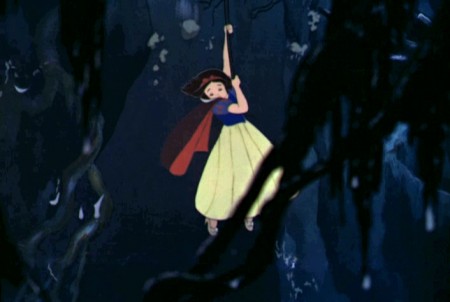 6f
6f
We catch up to her holding onto a vine above water.
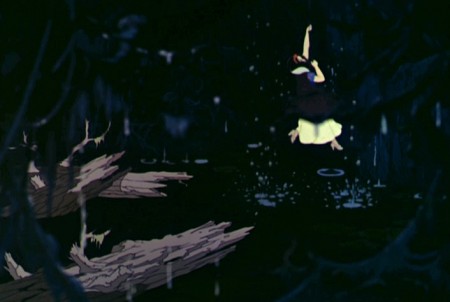 7a
7a
A quick cut back to reveal the environment.
 7c
7c
She’s frightened by two logs that look like alligators.
 8a
8a
Cut with her running out of the water.
 8b
8b
Out of focus shrubbery blocks our view of her.
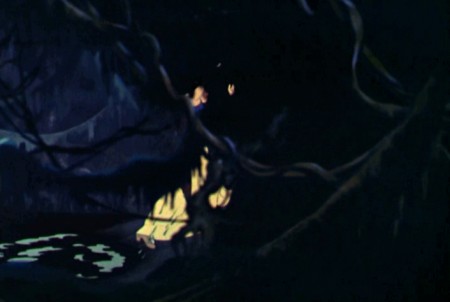 8c
8c
She continues moving under the shrubbery.
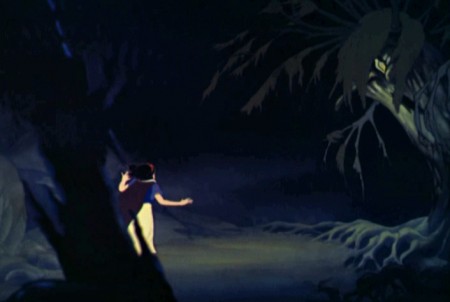 8d
8d
She finally comes out of the hole.
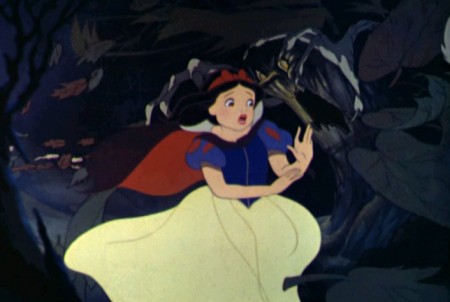 9a
9a
Frightened by the trees she runs forward screen right.
 9b
9b
Cut as she enters large from screen left.
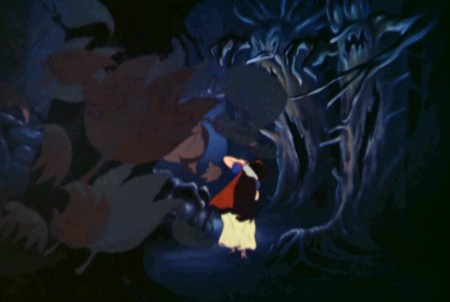 9c
9c
She runs into the perspective. Different levels of soft focus.
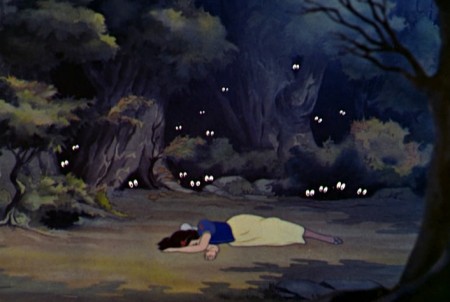 10a
10a
She’s frightened by eyes and falls to the ground.
In this shot the eyes seemed to be burned in on a second pass.
As the camera moves out, they don’t move at the same rate
causing some slight gliding.
 10b
10b
Overlay trees slowly move into the frame.
The lighting of the scene brightens.
 10c
10c
Finally, we’re settled watching her on the ground
surrounded by innocent pastoral animals.
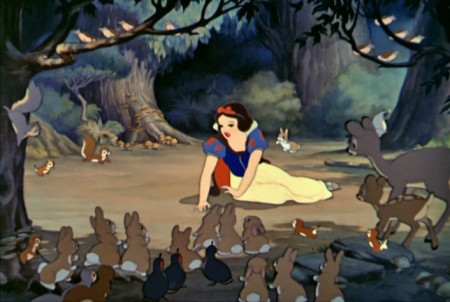 11
11
Snow White on the ground with all the animals
does not employ the multiplane camera.
 12
12
However, we immediately see a deer over a waterbed surrounded by trees.
This does use the camera to place the water effect in among the foliage.
There are plenty of shrubs out of focus above the water.
 13a
13a
The same goes for this shot of raccoons.
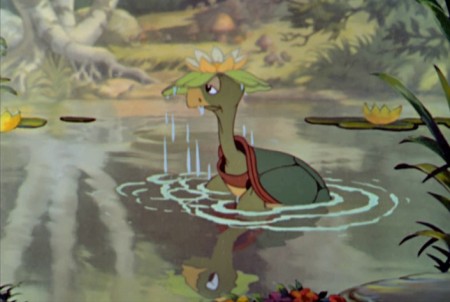 13b
13b
The raccoons run out in the pick up of this shot, and we truck in to a turtle.
The multiplane level of the water separates from what’s under it.
 14a
14a
Snow White is led by the animals through a wooded area
filled with multiplane levels.
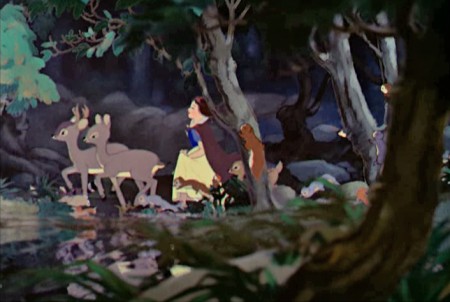 14c
14c
The water effect has a level all its own.
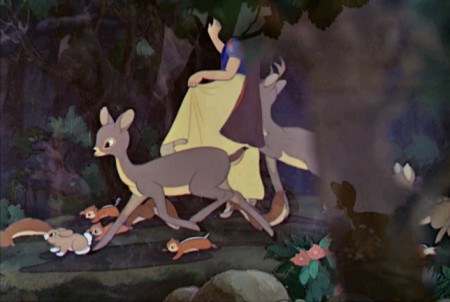 14f
14f
How more apparent is the multiplane level than this one
that blurs out in an area that visually cuts off her head.
 15a
15a
Snow White comes out to a clearing and is pulled to screen left.
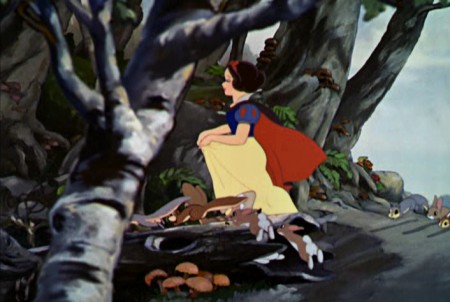 15b
15b
Plenty of objects pass in soft focus.
 15d
15d
The animals open to a clearing.
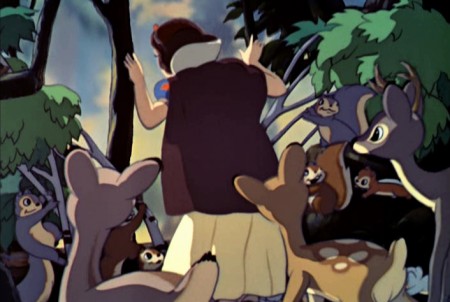 15g
15g
There’s a light change as Snow White views out . . .
 16
16
. . . to see the dwarf’s house. No camera move, but the
multiplane still is used to create a feeling of depth.
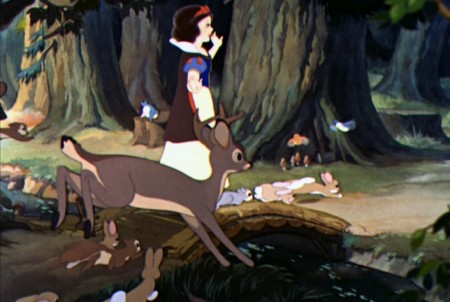 17a
17a
A few shots later, Snow White runs across a little foot bridge.
 17b
17b
She heads for the dwarf’s house.
 17c
17c
Out of focus trees pass over her and the animals.
Disney &Frame Grabs 27 Jun 2011 06:28 am
More Pinocchio Multiplane
- I had such a good time last week posting images of scenes from Pinocchio using the multiplane camera that I decided to go back to the well. There are a lot of very small shots in that film that use the camera for a more limited but very effective purpose.
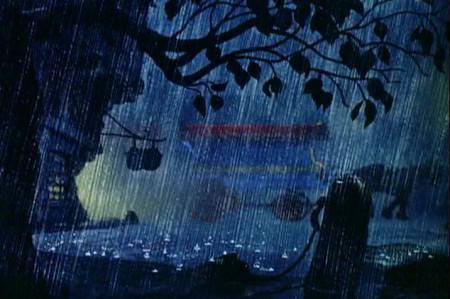 1
1A vaguely seen wagon rolls across the screen in a heavy rain storm.
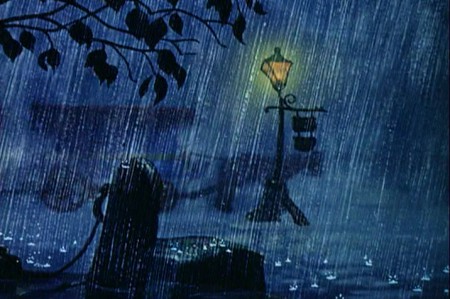 2
2
The camera pans across the screen with the wagon.
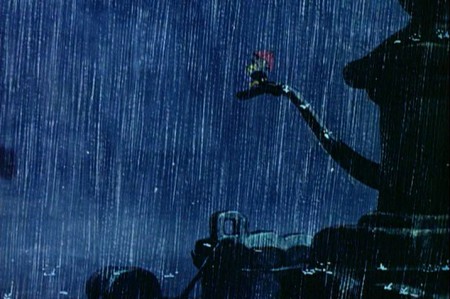 3
3
Camera trucks in to the water spout.
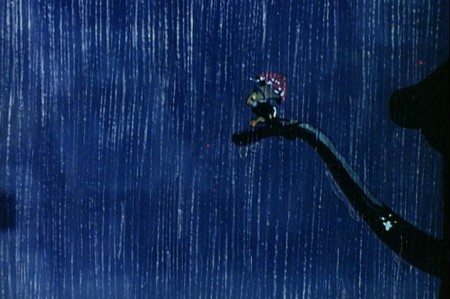 4
4
Jiminy sits on the water spout in the rain.
cut
 5
5
The wagon sits at rest in the rain
cut
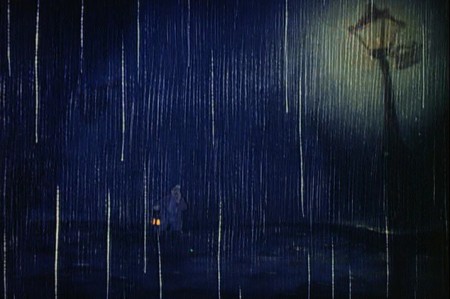 7
7
Gepetto in the far distance, in the rain, walks toward the camera.
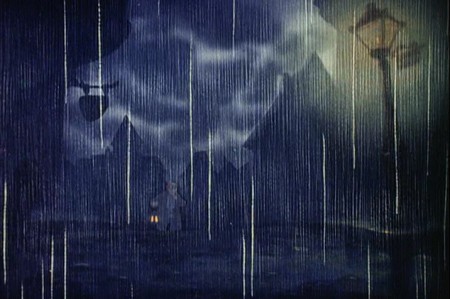 8
8
Lightning lights up the background.
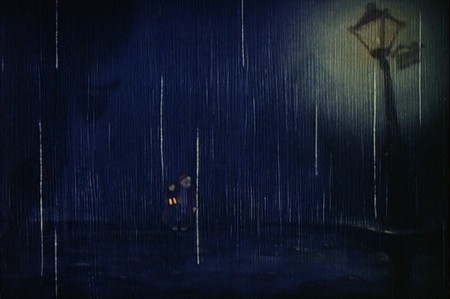 9
9
Barely seen Gepetto moves forward calling for “Pinocchio!”
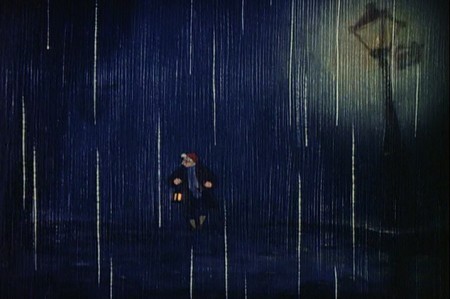 10
10
Gepetto slowly moves forward
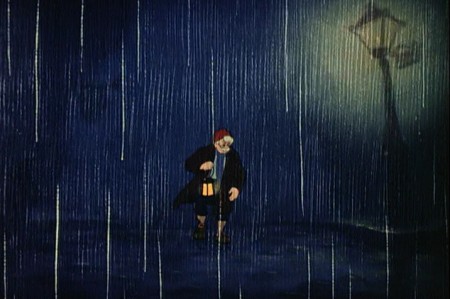 11
11
He continues on in the rain.
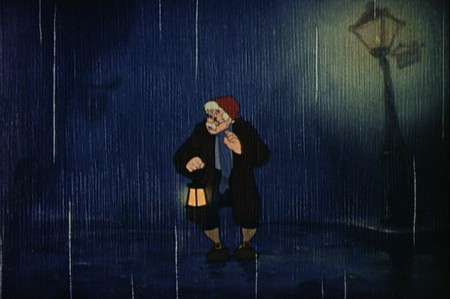 12
12
He hears the wagon approaching screen left.
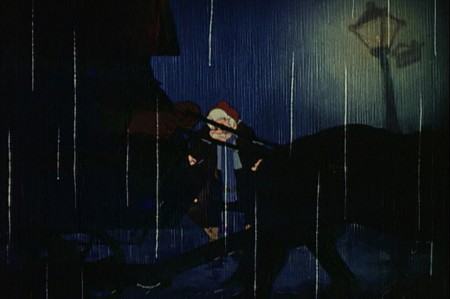 13
13
The wagon moves in front of him (slightly out of focus).
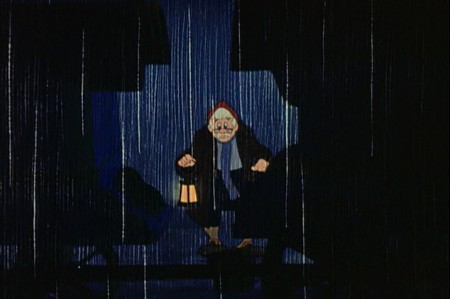 14
14
The wagon blocks across Gepetto who watches it.
At one point when I worked at the Hubley studio, John and Tissa David had a laughing disagreement. She had animated something with a couple of overlays panning over the background trying to create some sense of dimension.
John told Tissa that she was moving the overlays too quickly; they would look as though they were moving of their own accord, not that it would look like dimension as the camera moved in. She was adamant that she was doing it correctly. John told her that he had received a phone call from an historian in Europe. The guy had told John that he admired the way he used the multiplane camera on the carriage ride to Pleasure Island. The historian felt it was the best use of the multiplane, ever. John told Tissa that he had proof, then, that he knew what he was talking about. Tissa laughing, agreed to change her panning overlays.
I thought it’d be a good point to look at the multiplane use throughout this entire sequence.
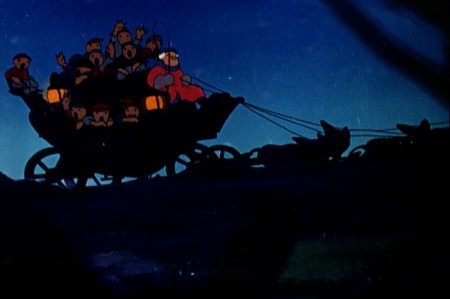 18
18We start with the carriage moving quickly through some wooded overlays.
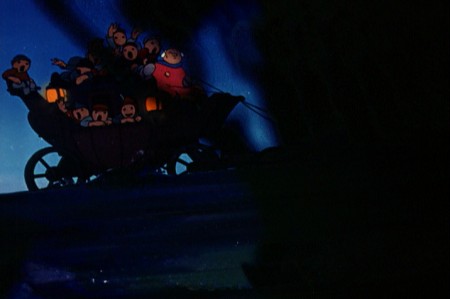 19
19
It’s definitely the multiplane. There’re levels of focus
and a very smooth movement to the panning trees.
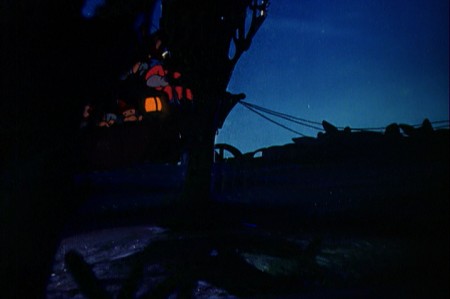 21
21
The overlays move quickly past.
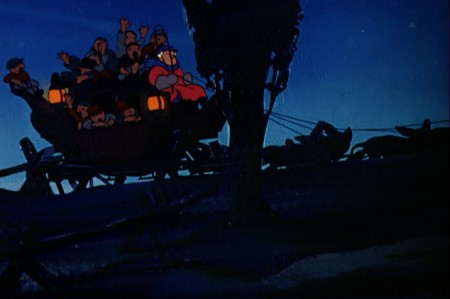 23
23
The overlay trees seem to have a slight highlight on the left side.
Could it be a cut line of a piece of paper picking up a light streak?
cut
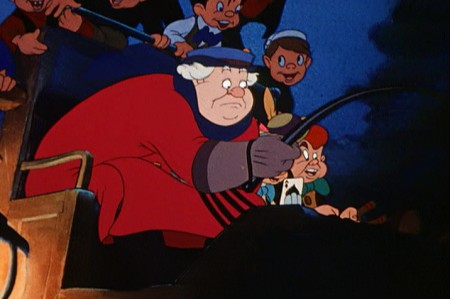 25
25
No multiplane as we see Coachman, Pinocchio and Lampwick in the driver’s seat.
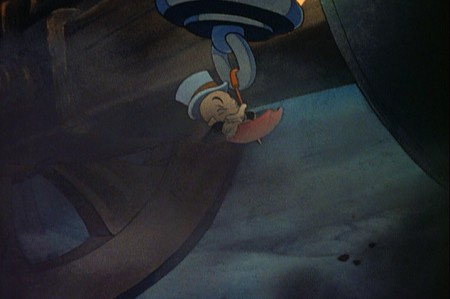 26
26
Jiminy with dust galore under the coach carriage.
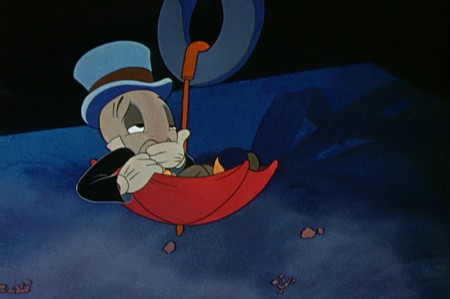 27
27
Cut in for a tighter, beautiful shot of Jiminy talking to the audience.
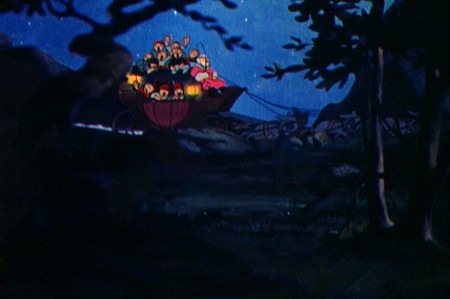 28
28
Back to the carriage moving quickly behind multiplane levels.
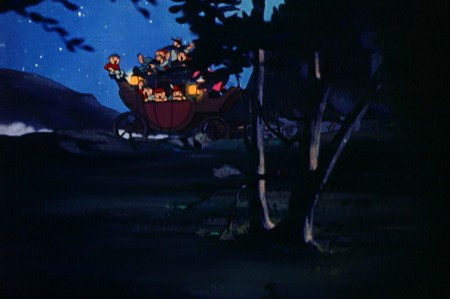 29
29
. . . it passes trees . . .
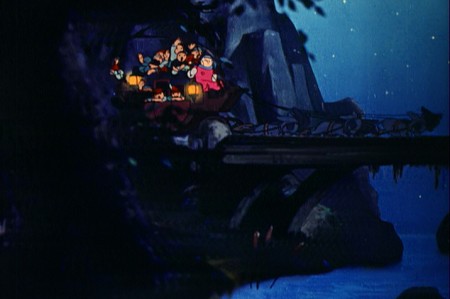 30
30
. . . and moves to a stone bridge . . .
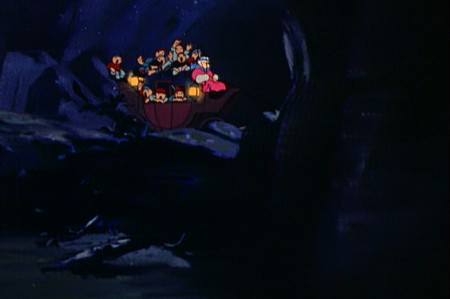 32
32
It comes to a pier and stops.
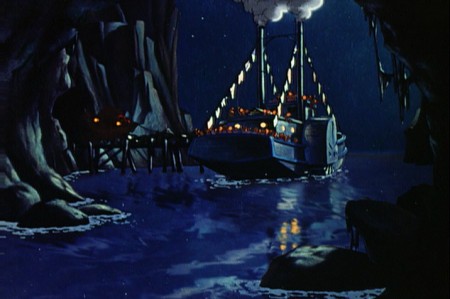 33
33
A steamship then takes them across the body of water.
No multiplane but quiet and beautiful water effects.
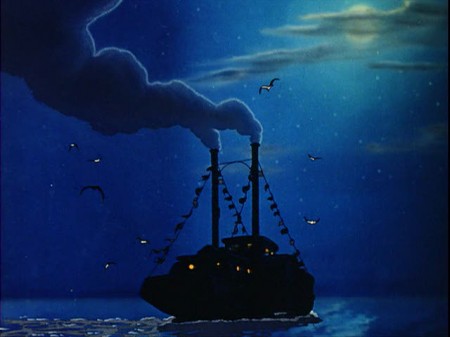 34
34
Dissolve to a beautiful shot of the steamship crossing.
No multiplane.
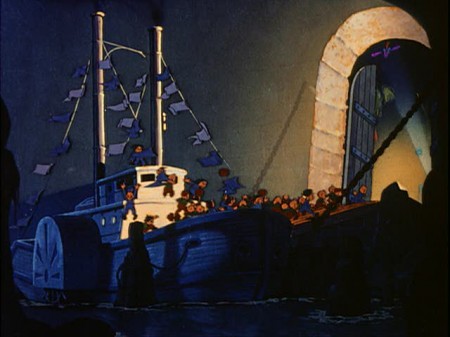 36
36
It finally stops at Pleasure Island.
No multiplane.
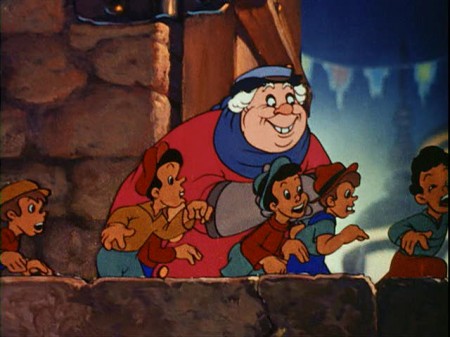 37
37
Pan with kids in front of coachman.
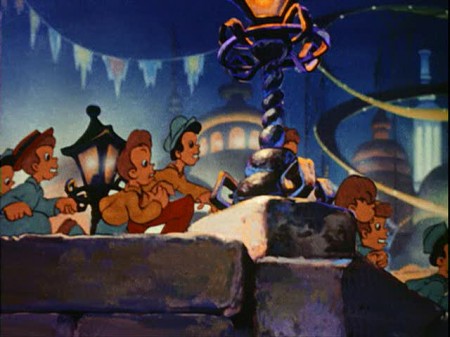 38
38
Across the screen as we open up . . .
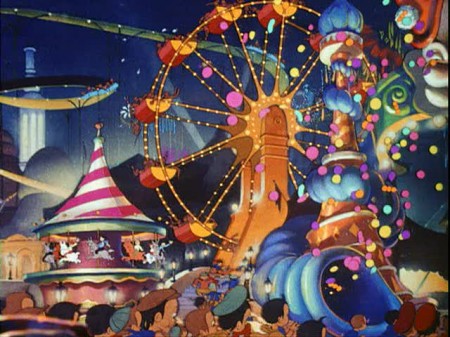 39
39
. . . to see Pleasure Island.
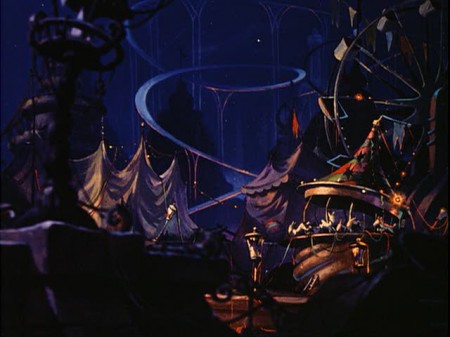 43
43
Late night. Destruction and desolation.
 44
44
A small pan across to the cowboy.
Very quiet use of the multiplane.
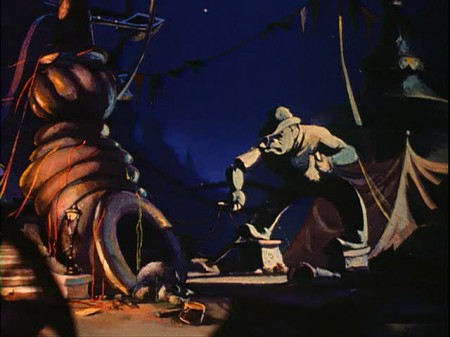 45
45
Notice the out of focus wheel in the left foreground.
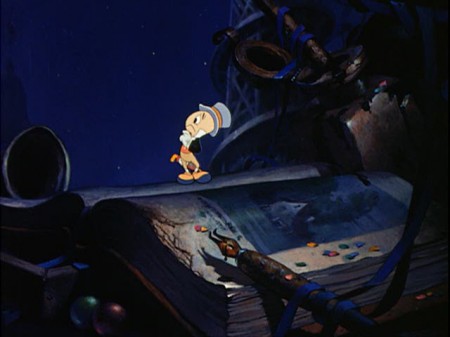 47
47
Jiminy climbs up from behind the hill and looks back calling for Pinocchio.
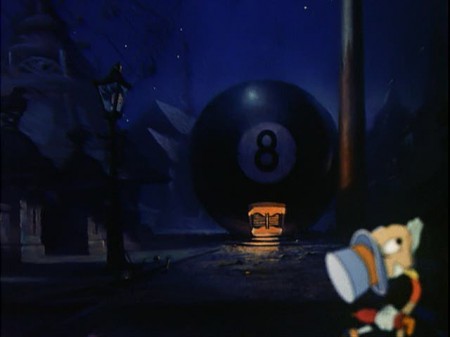 51
51
. . . going out of focus as we rack focus to the 8 ball in the Bg.
Here are a couple of drawings by Charles (Nick) Nichols done as part of the animation of the Coachman. The drawings come from the Canemaker book, Treasures of Disney Animation Art.
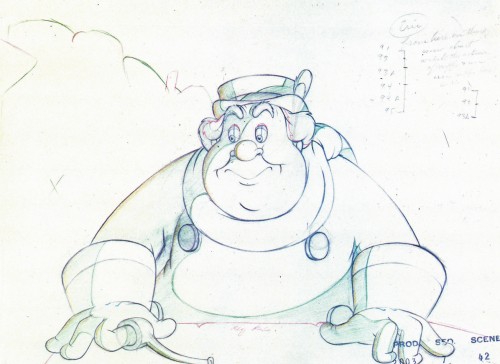 1
1
